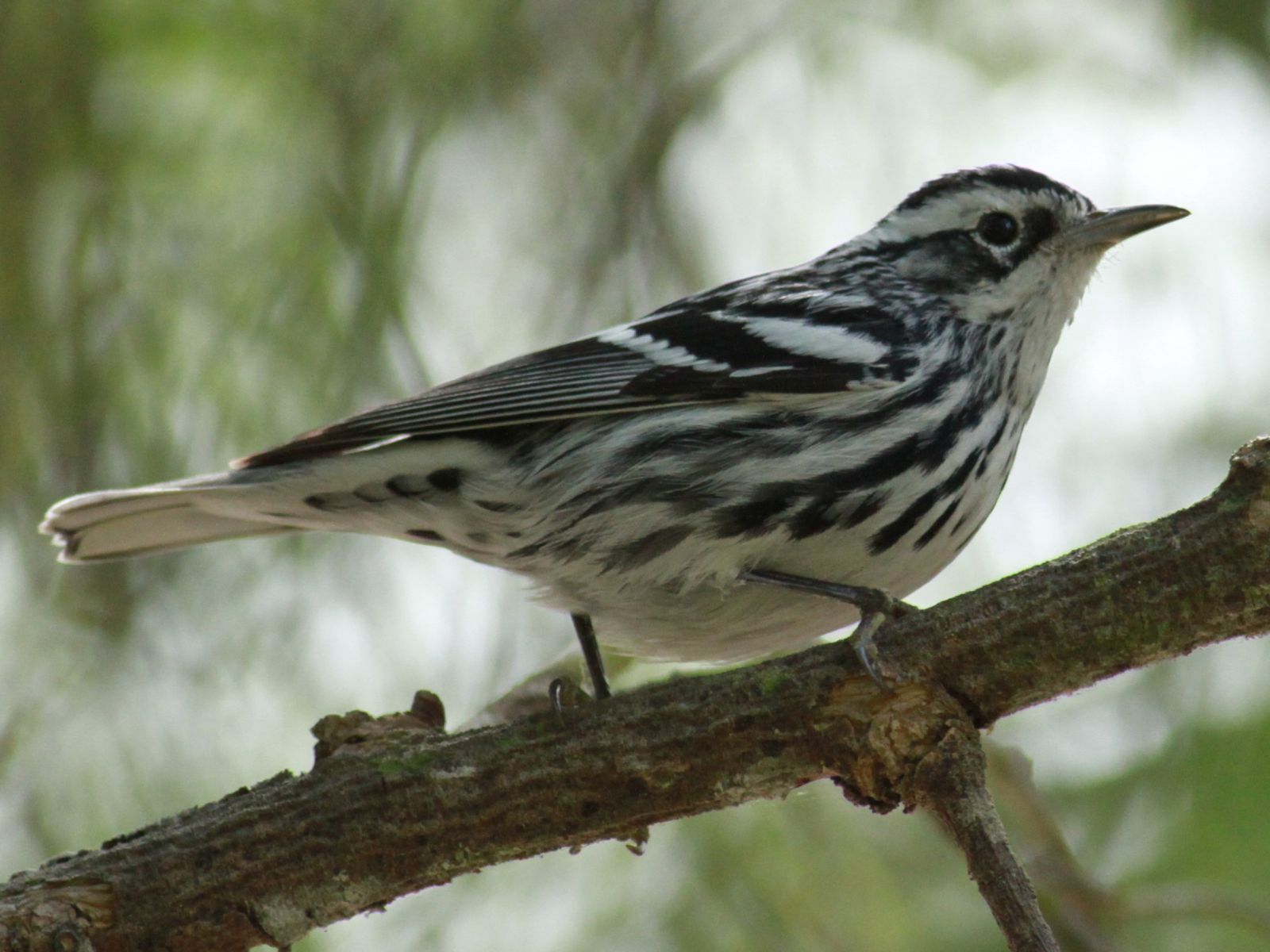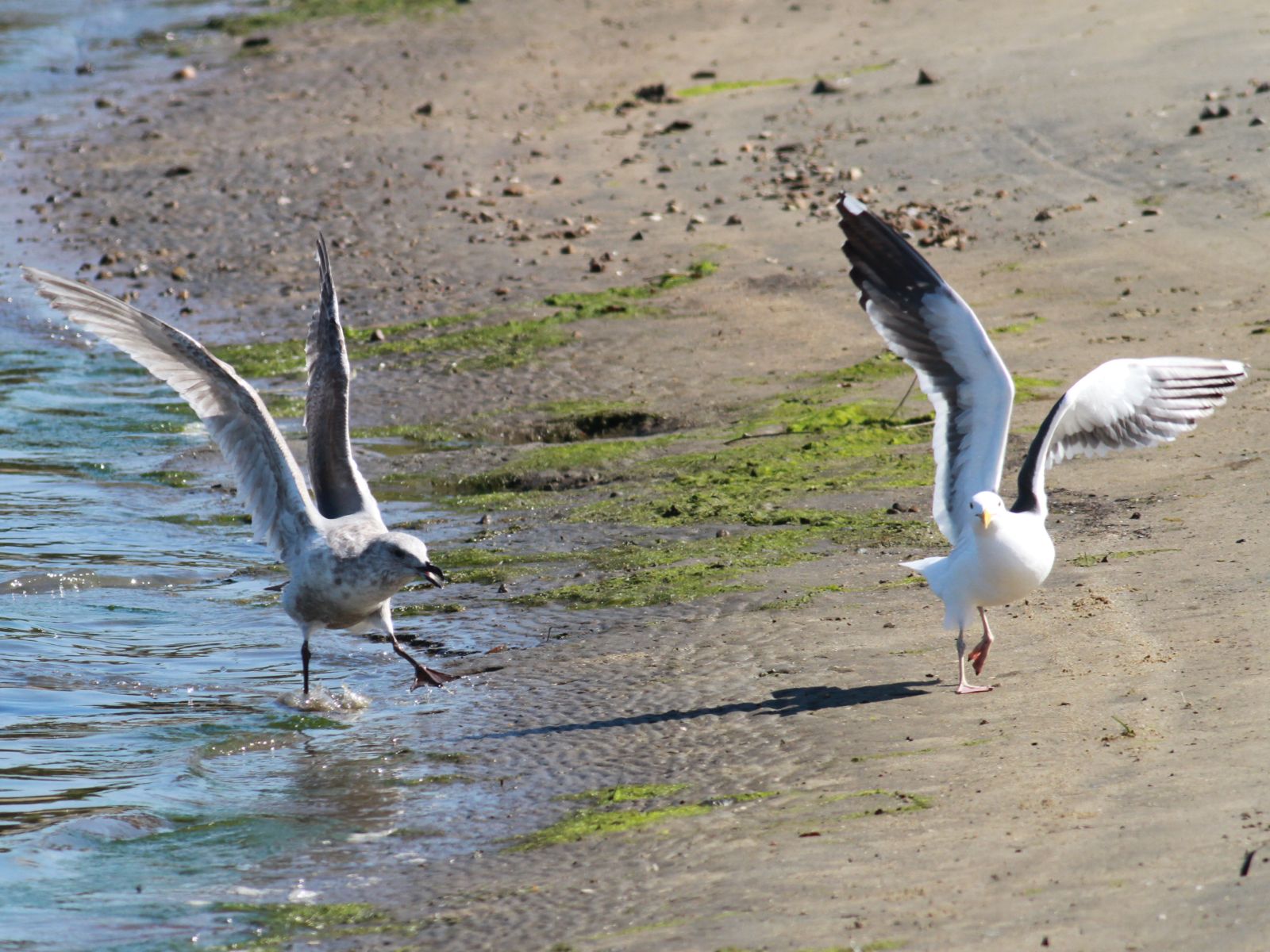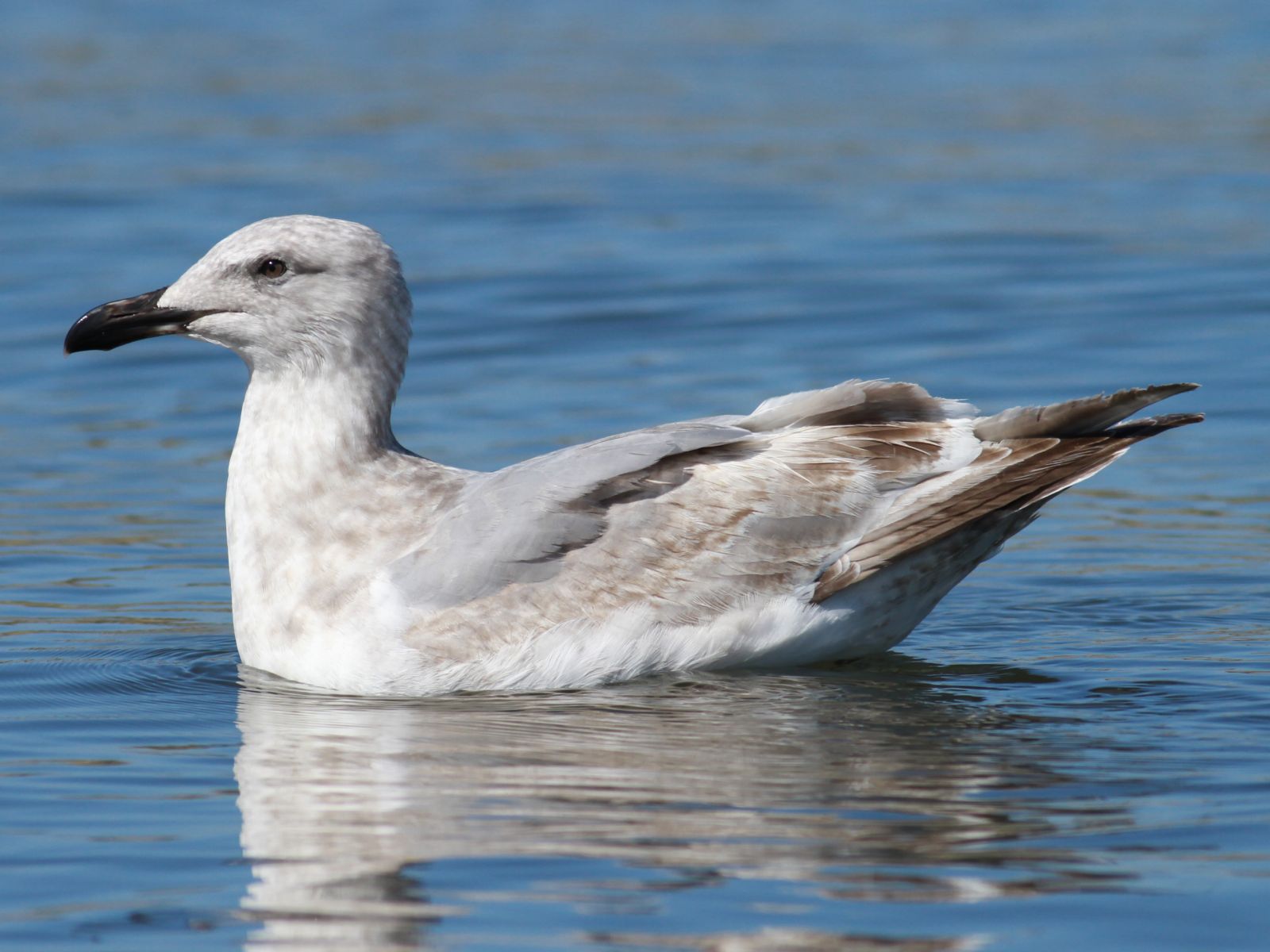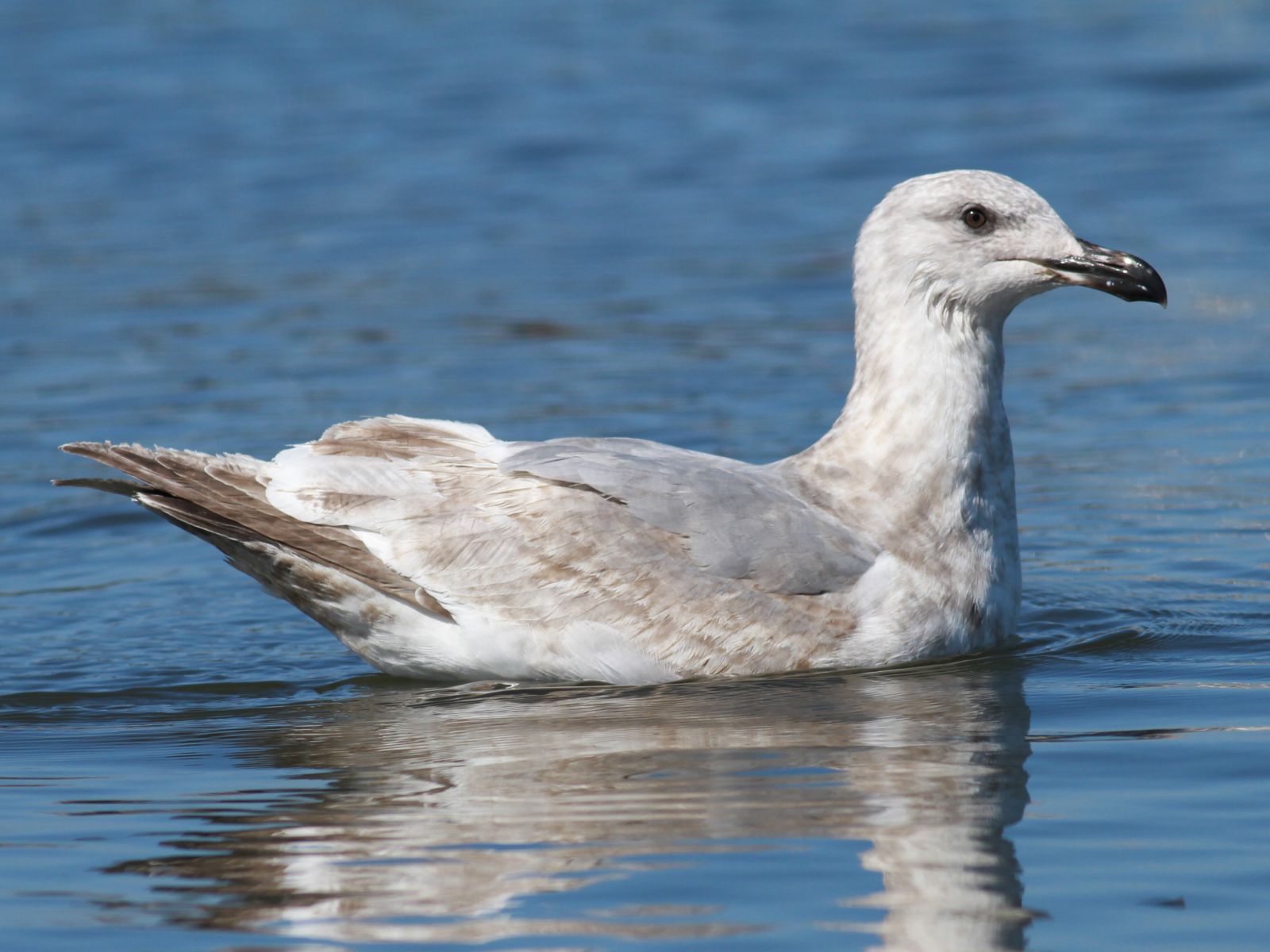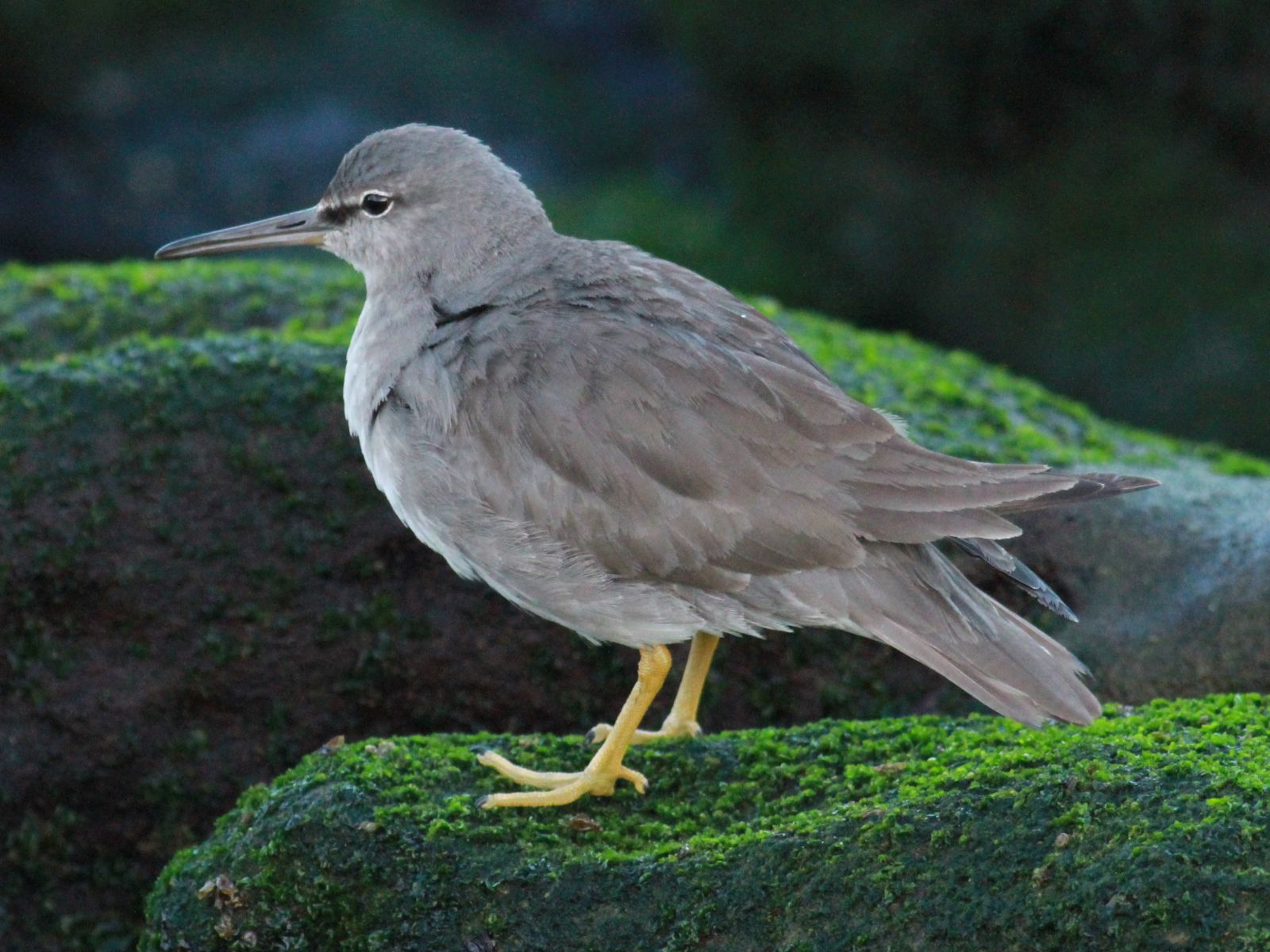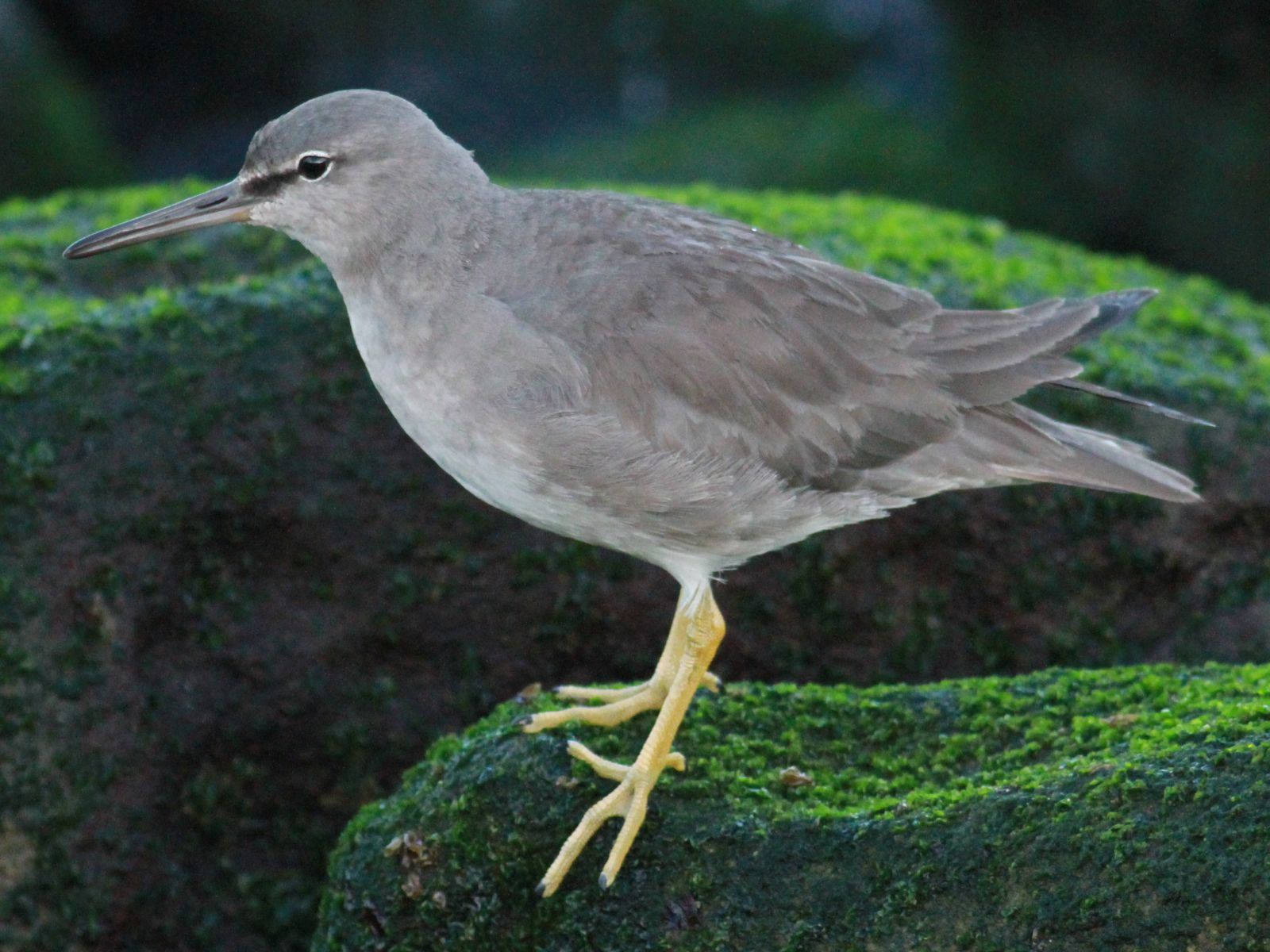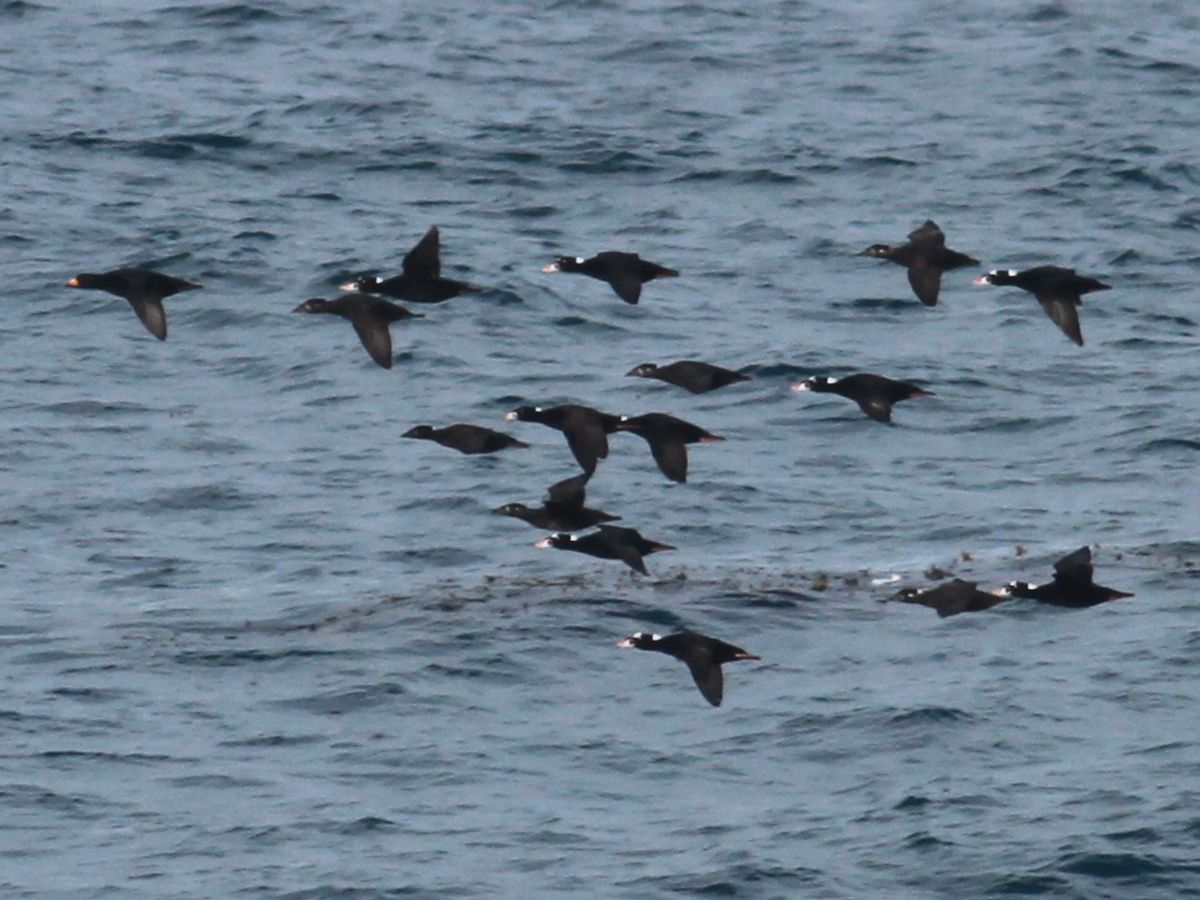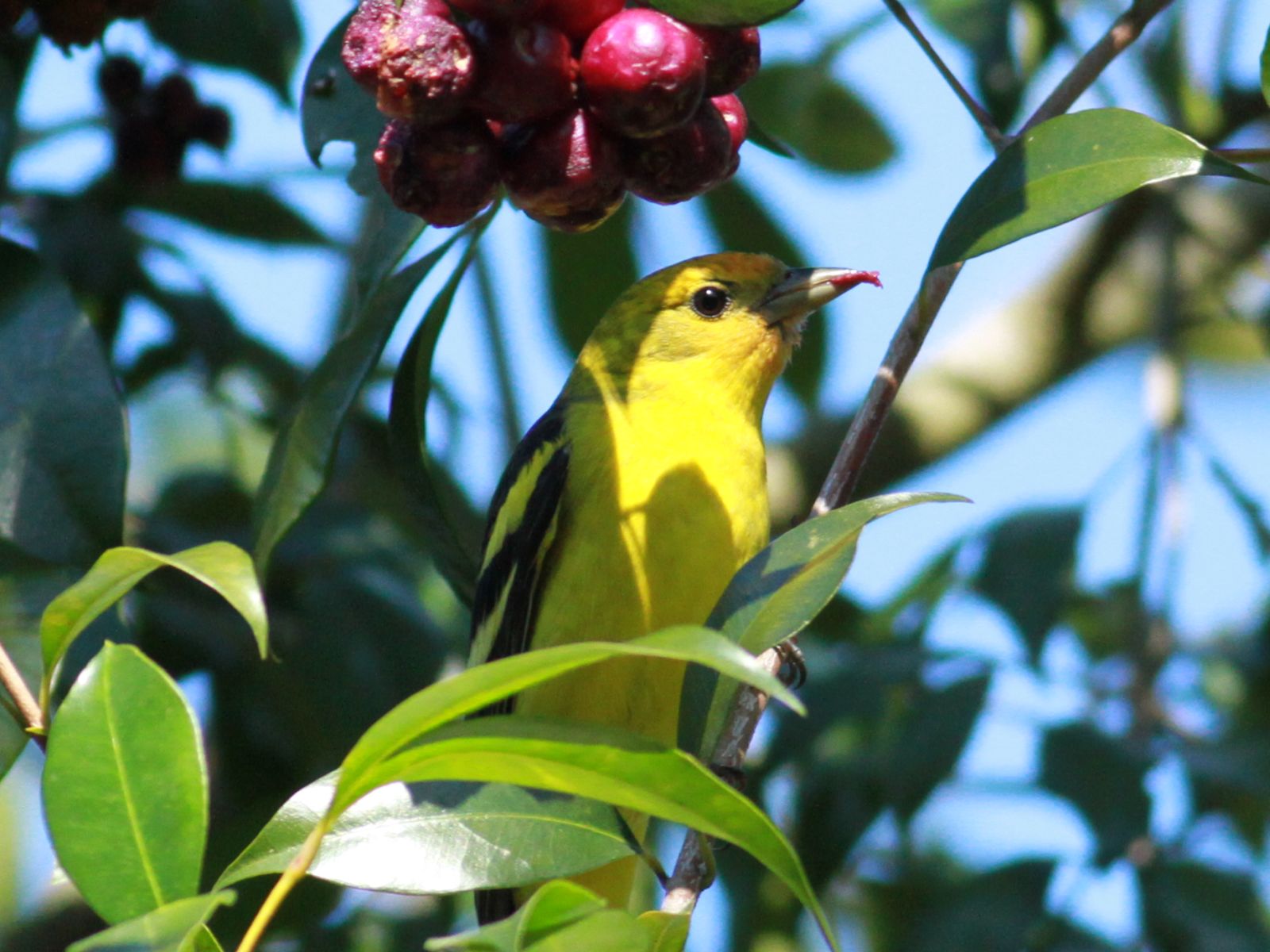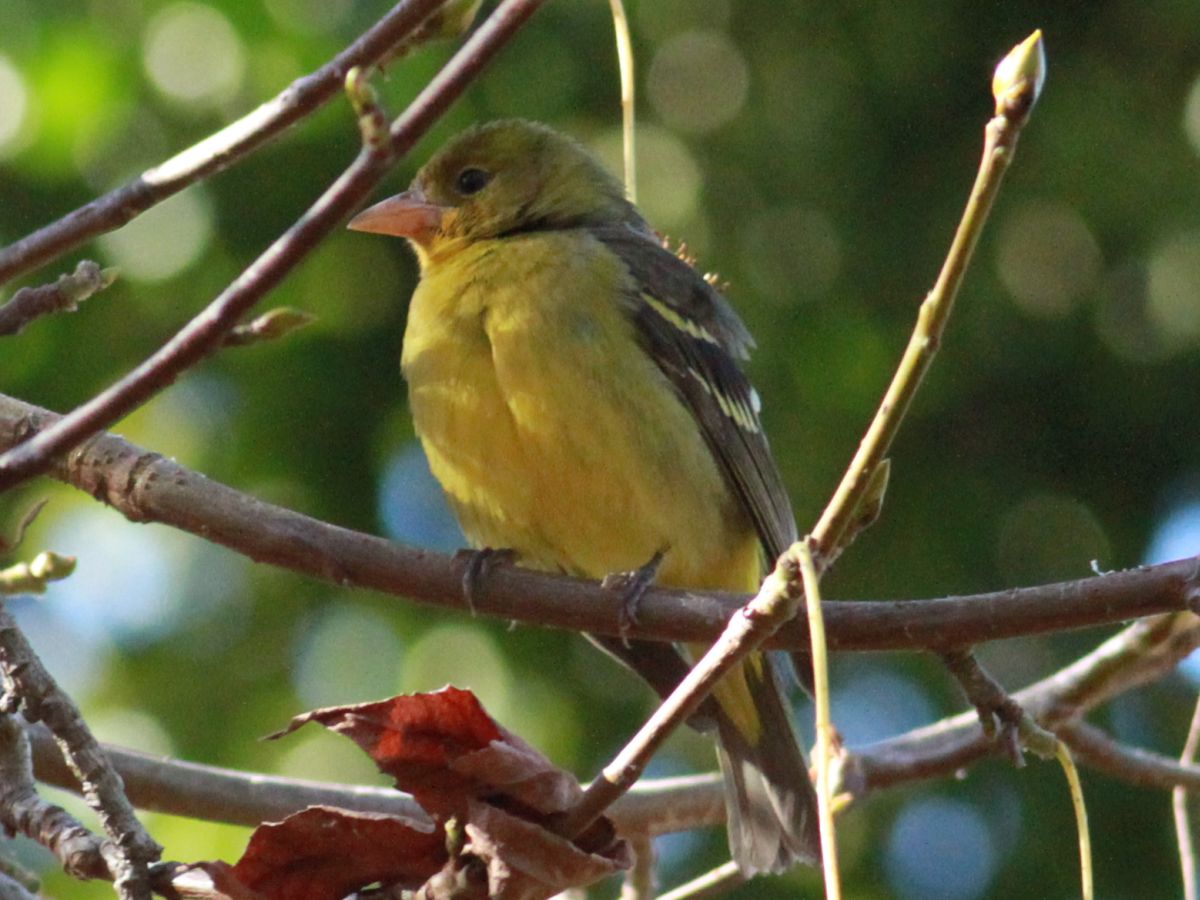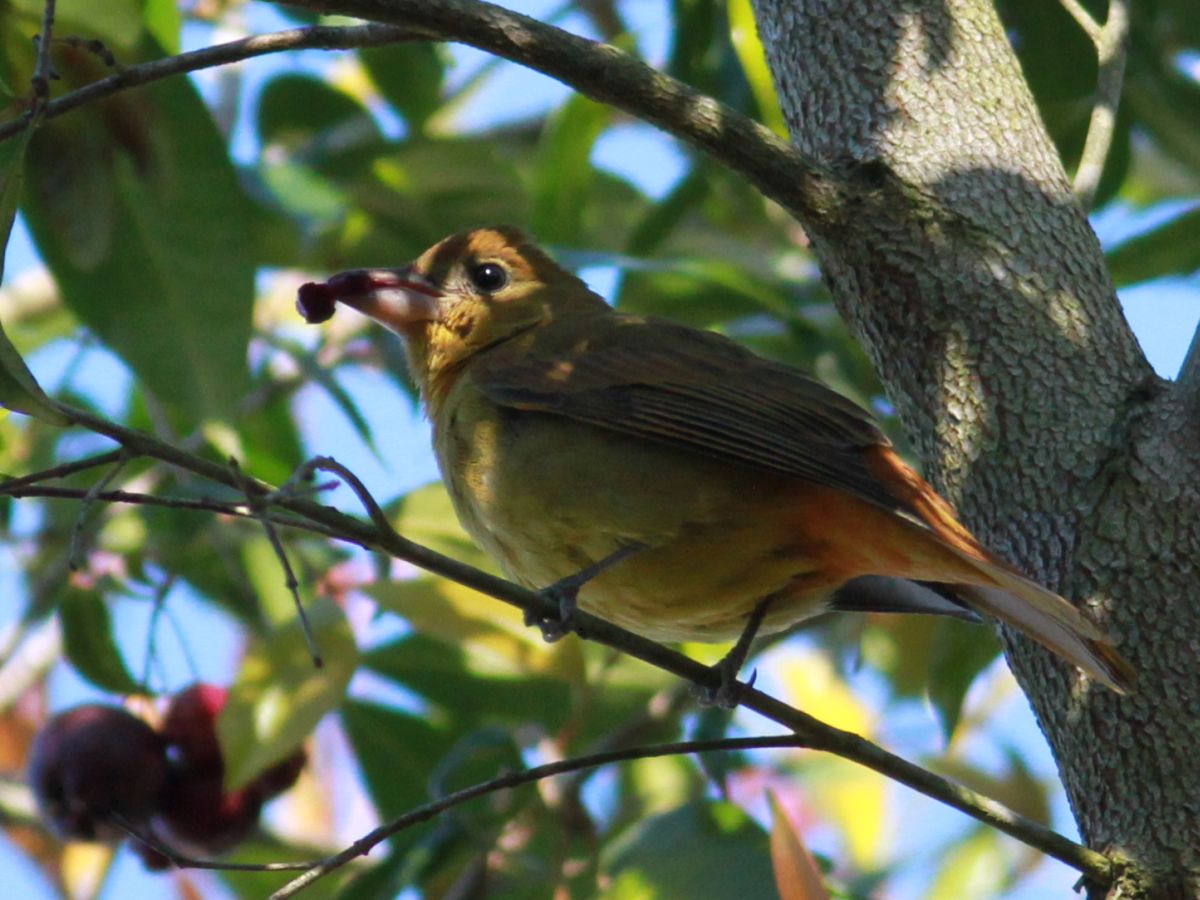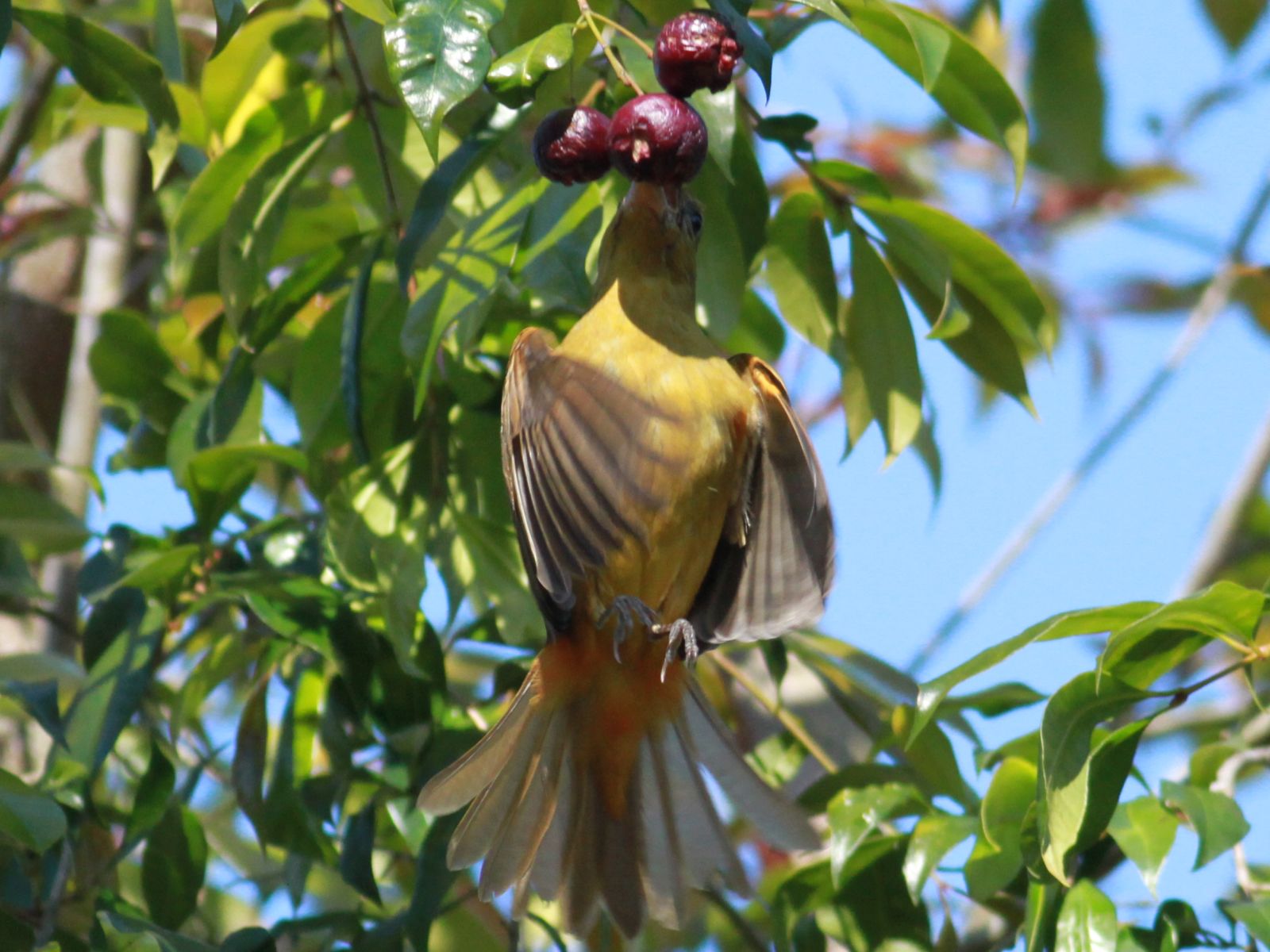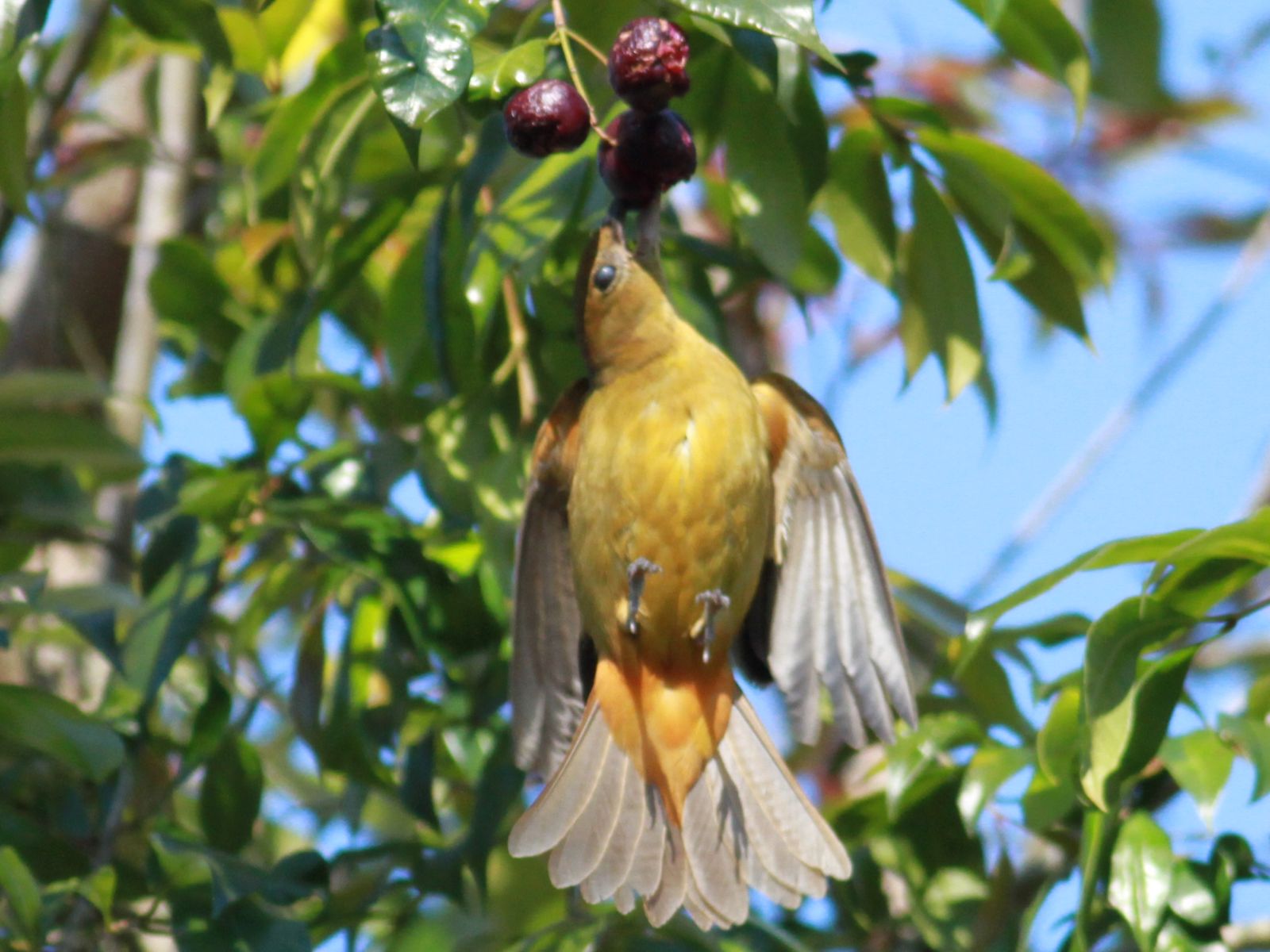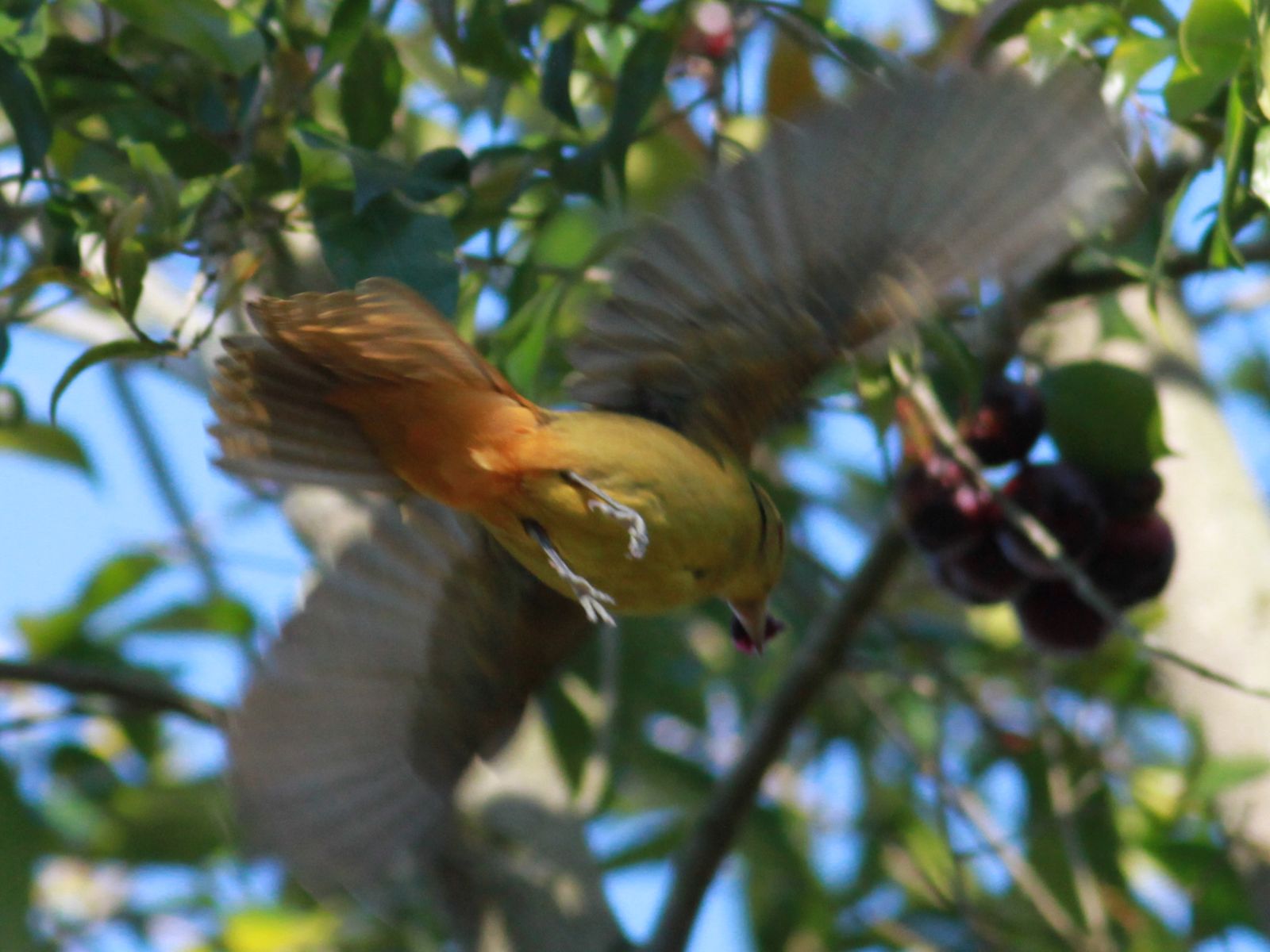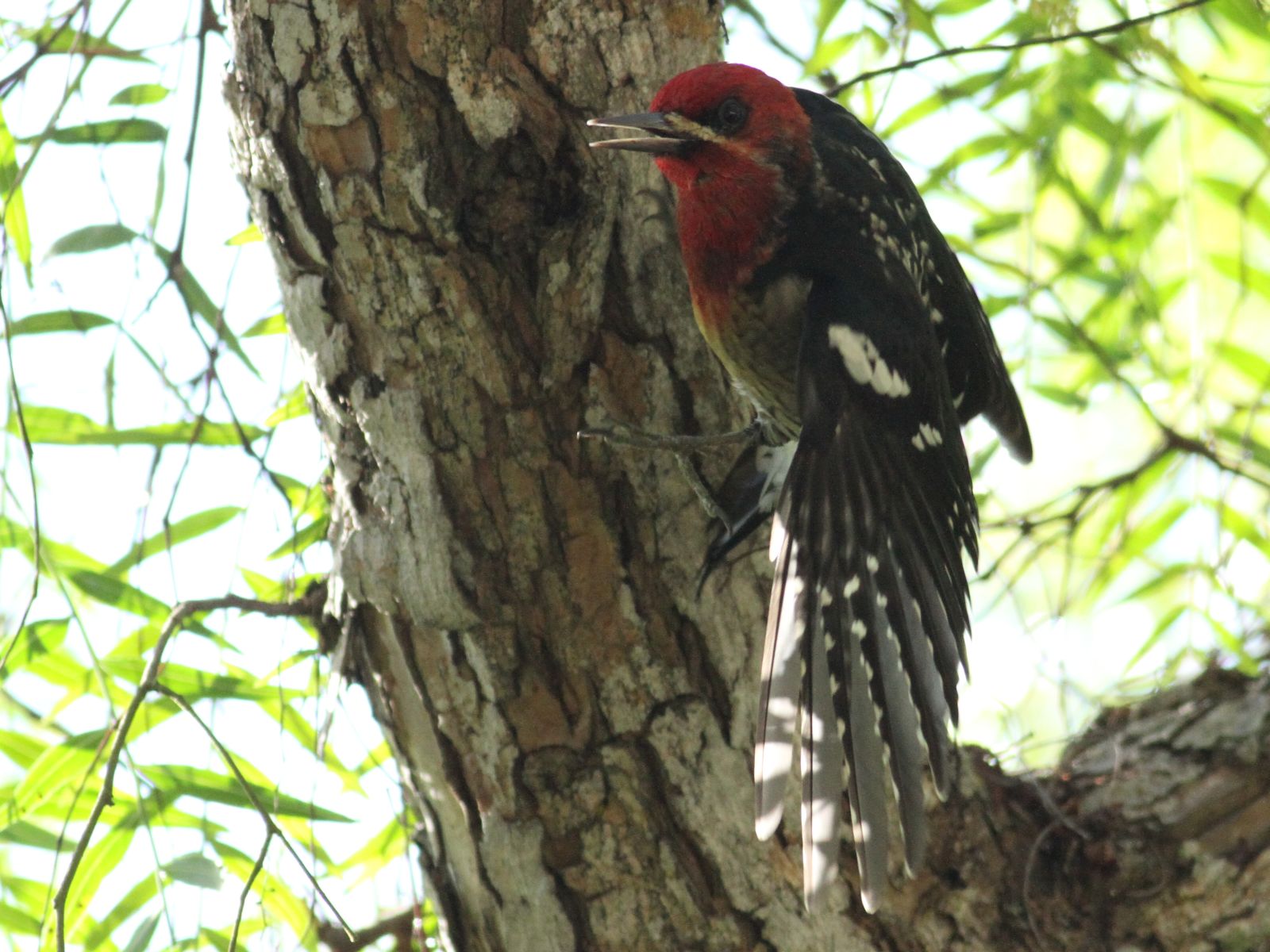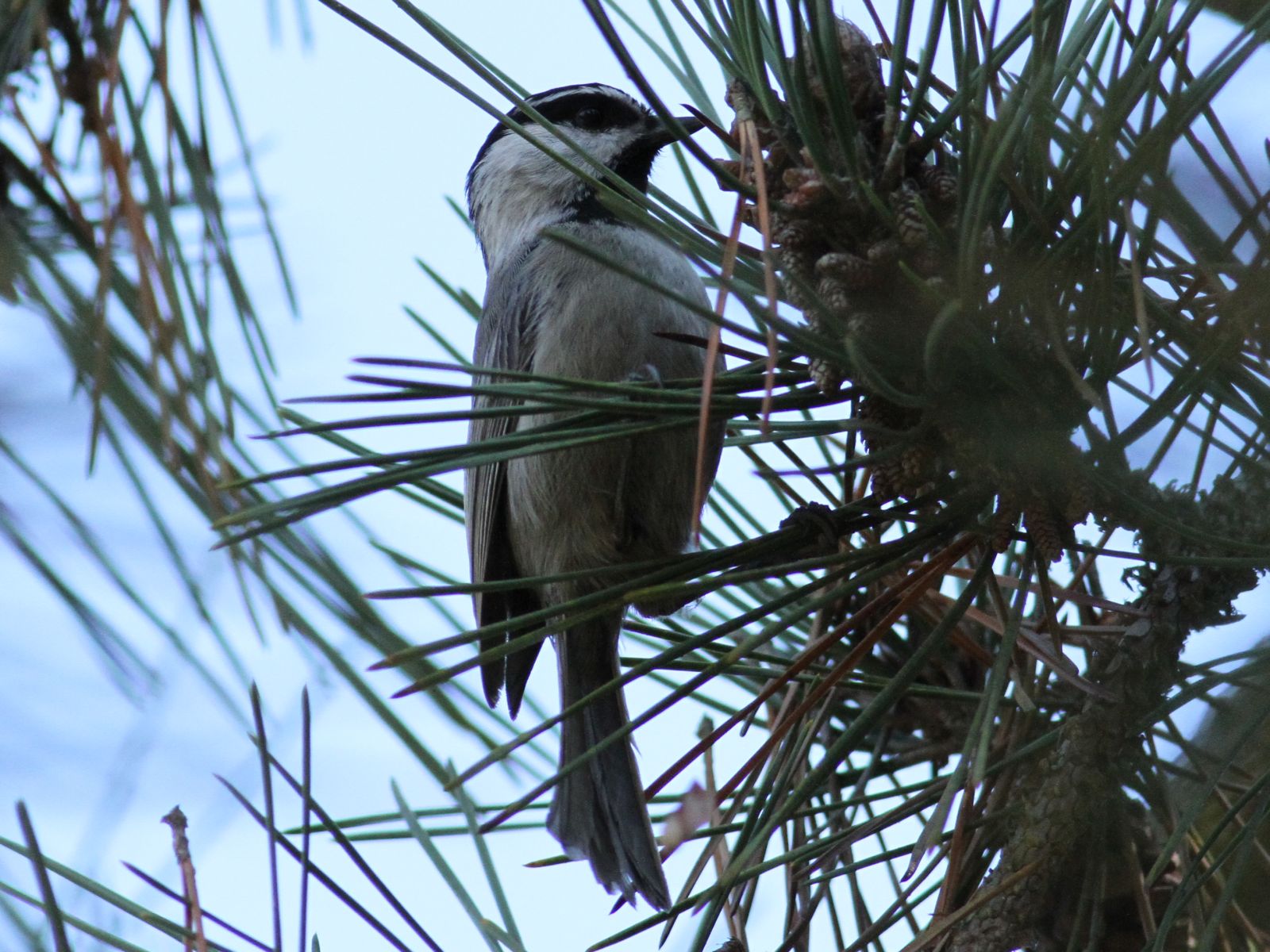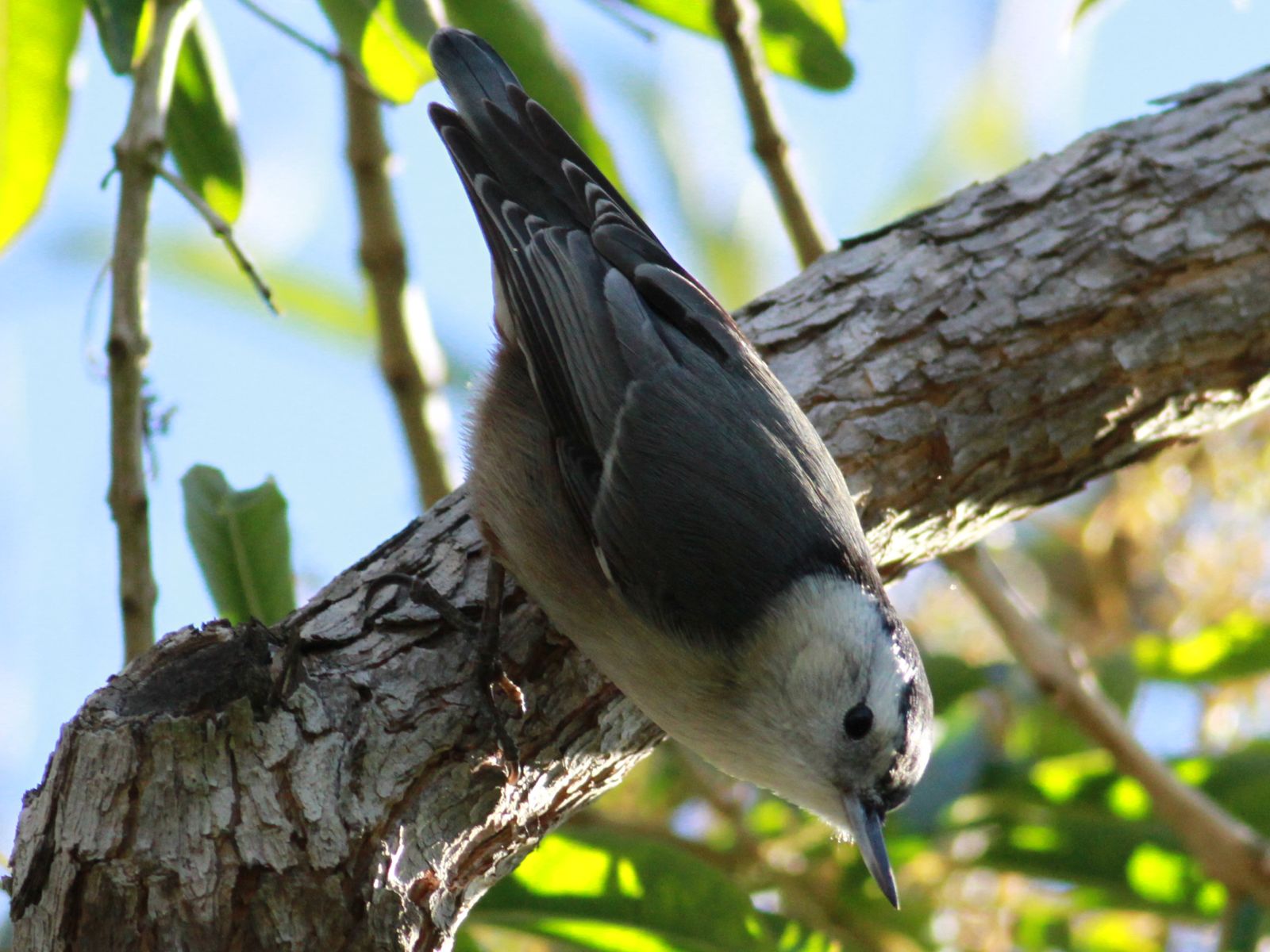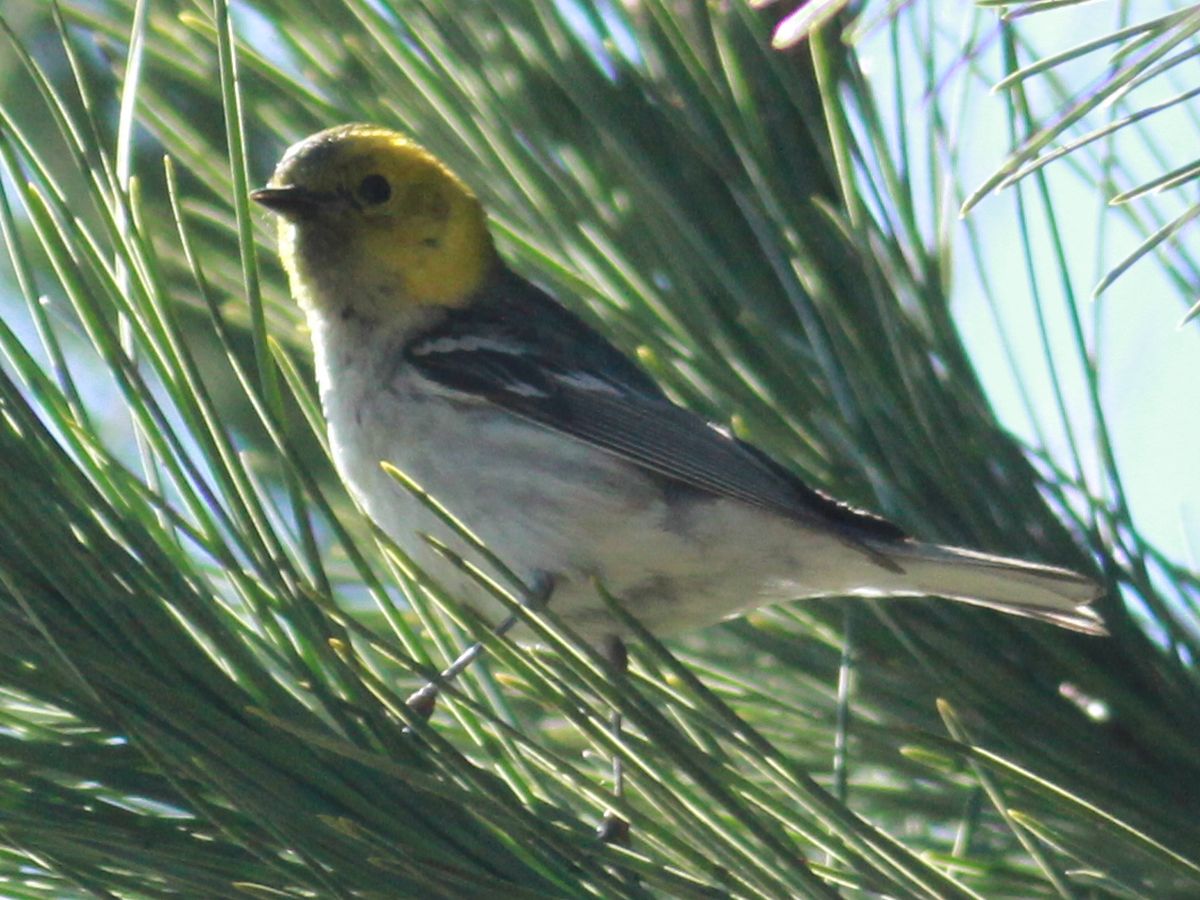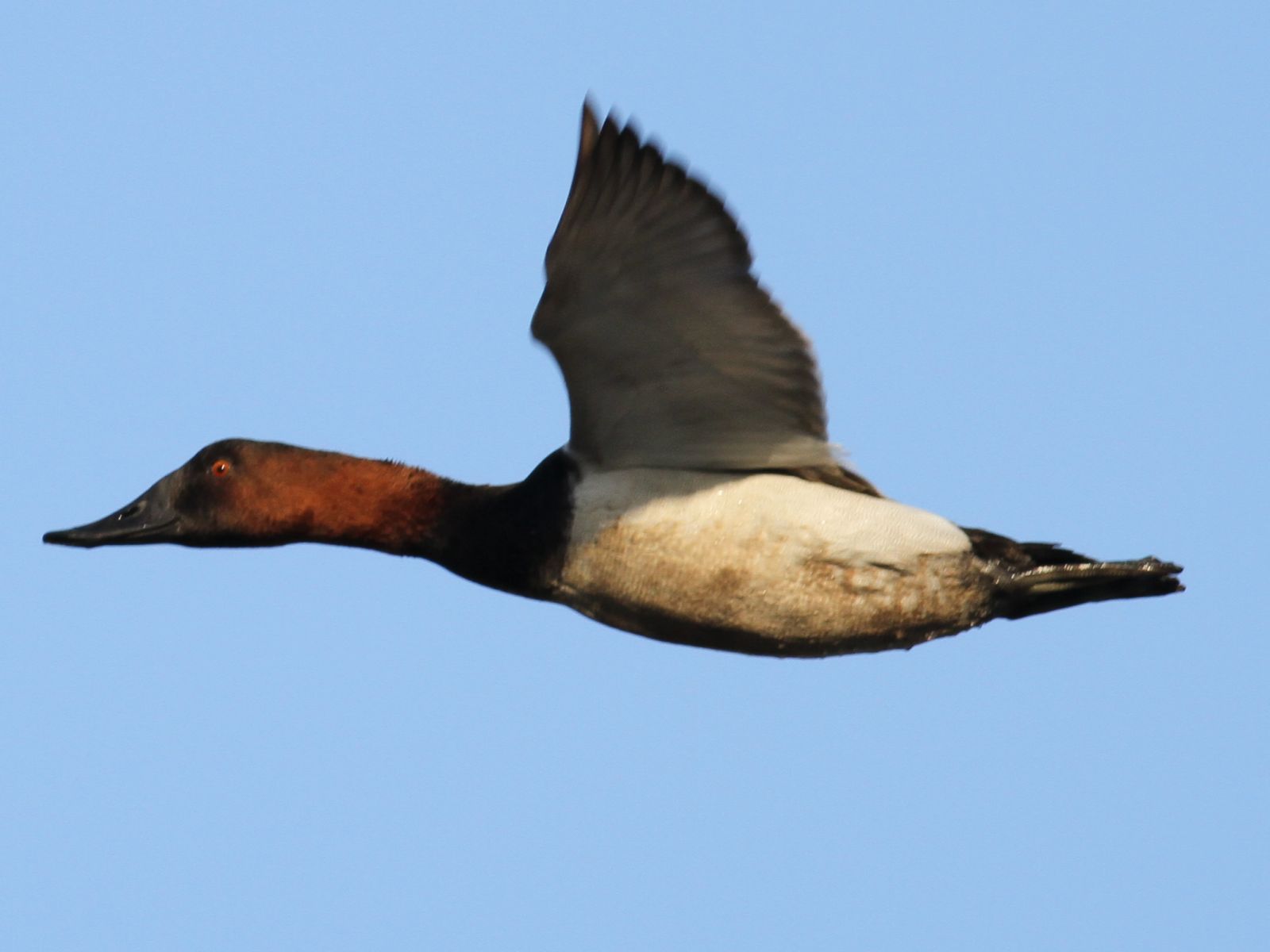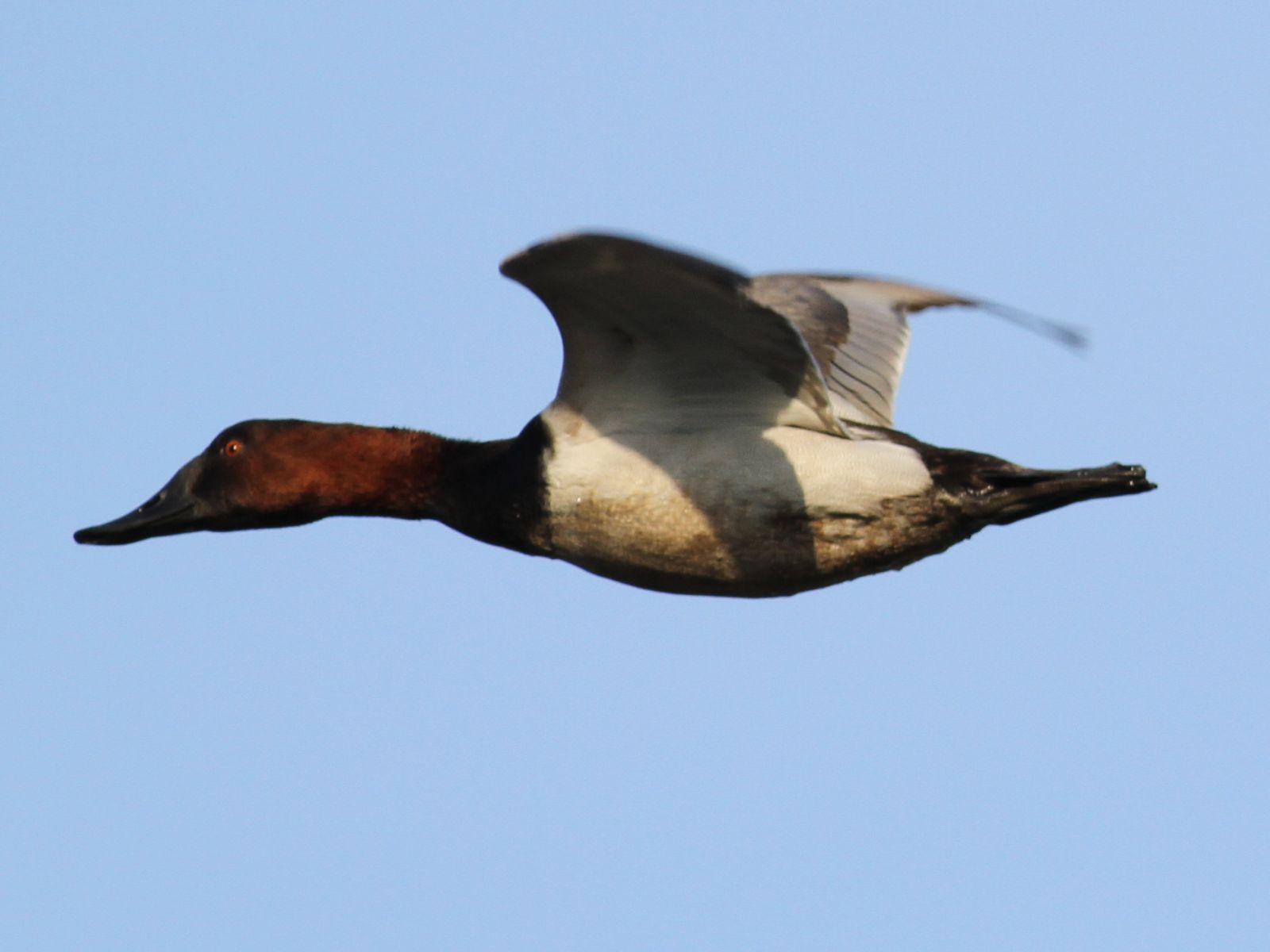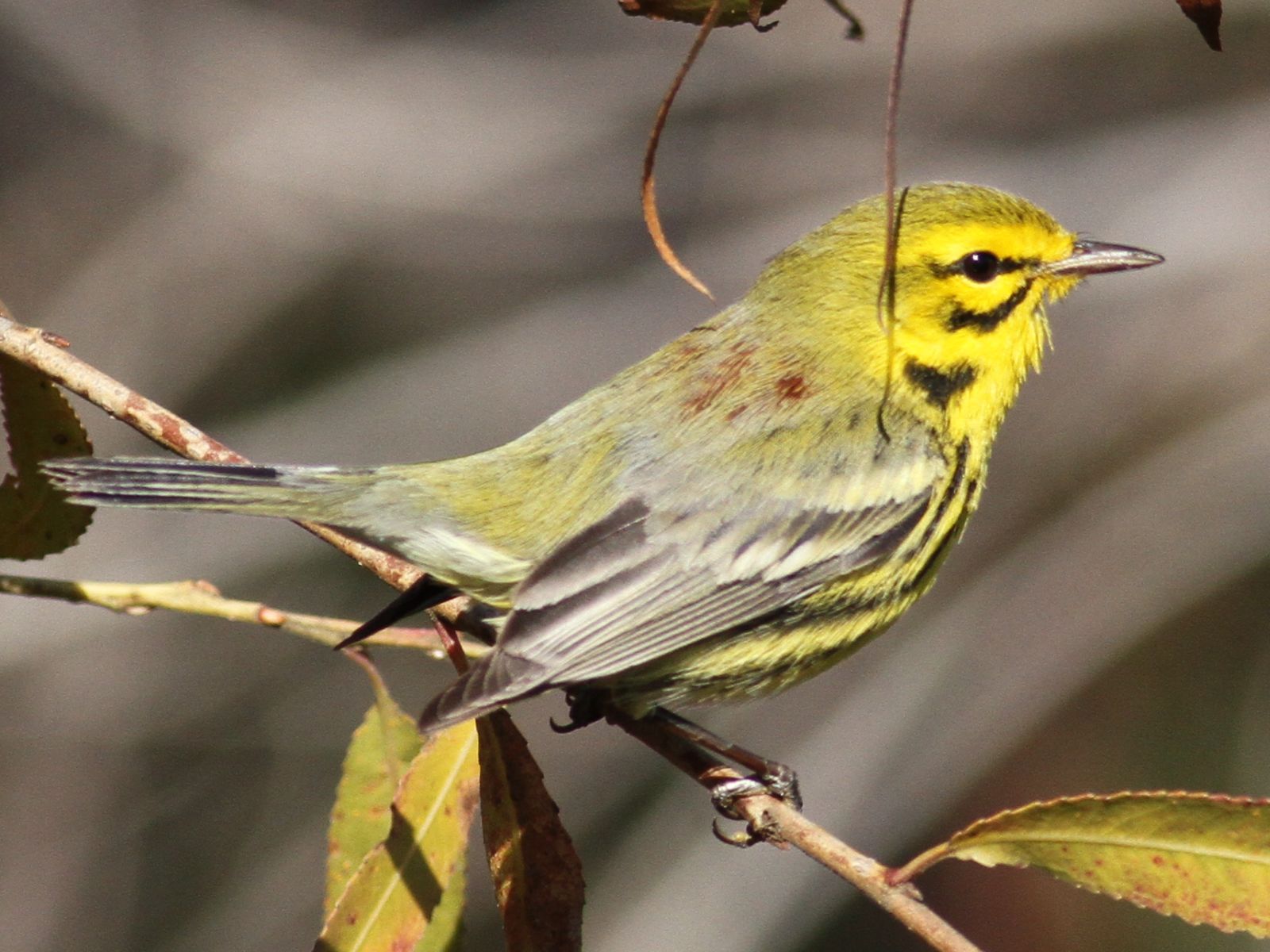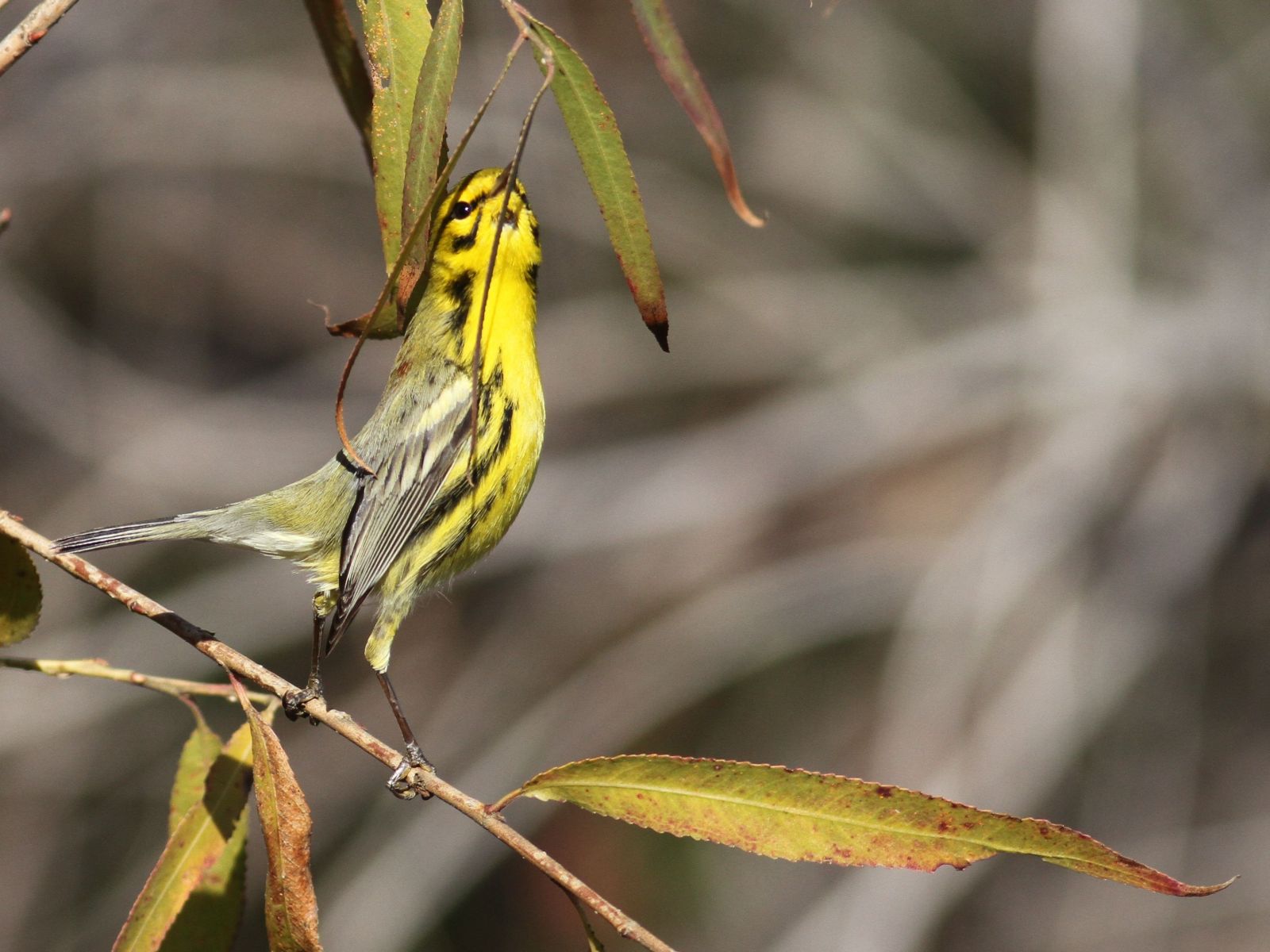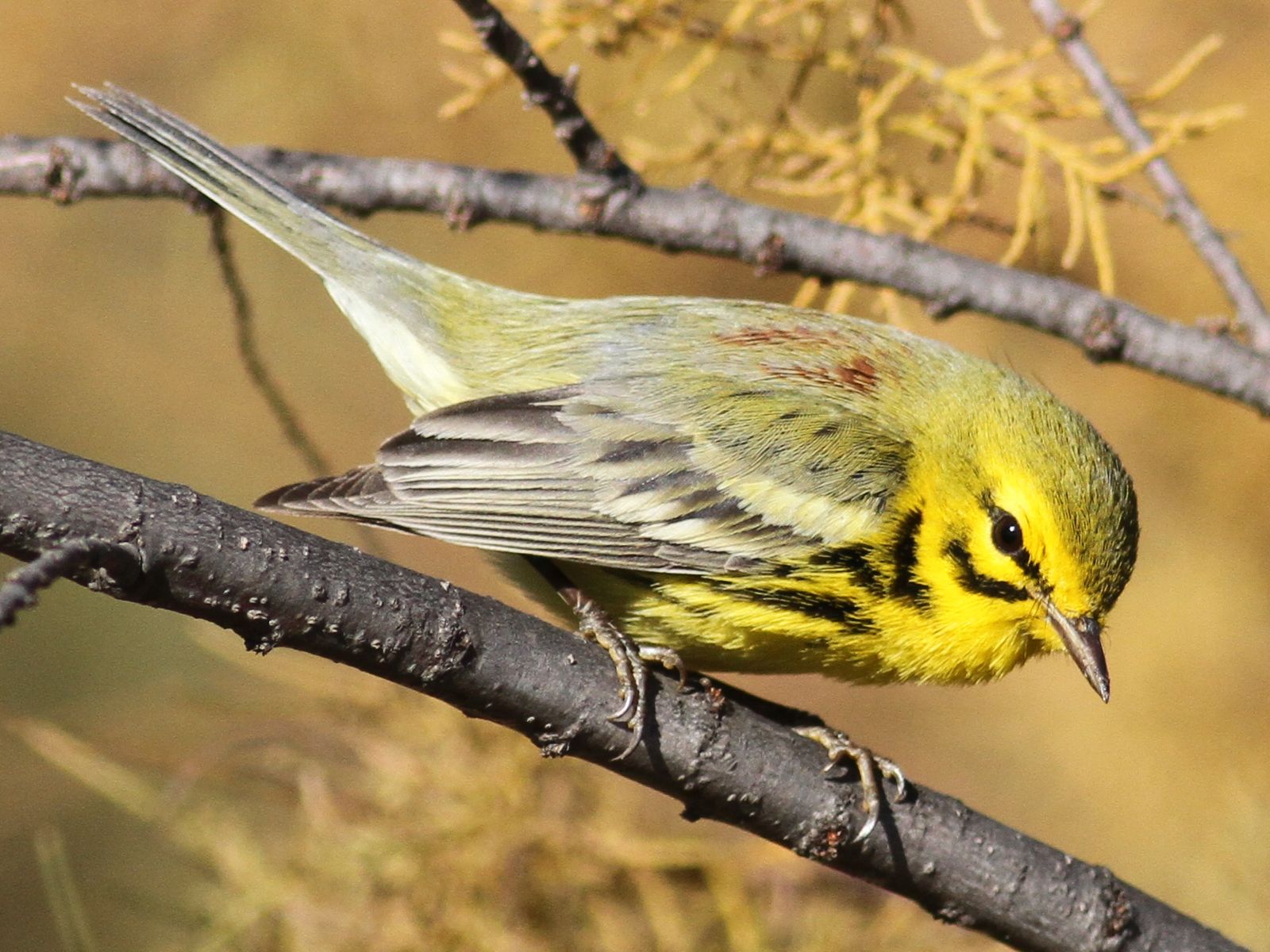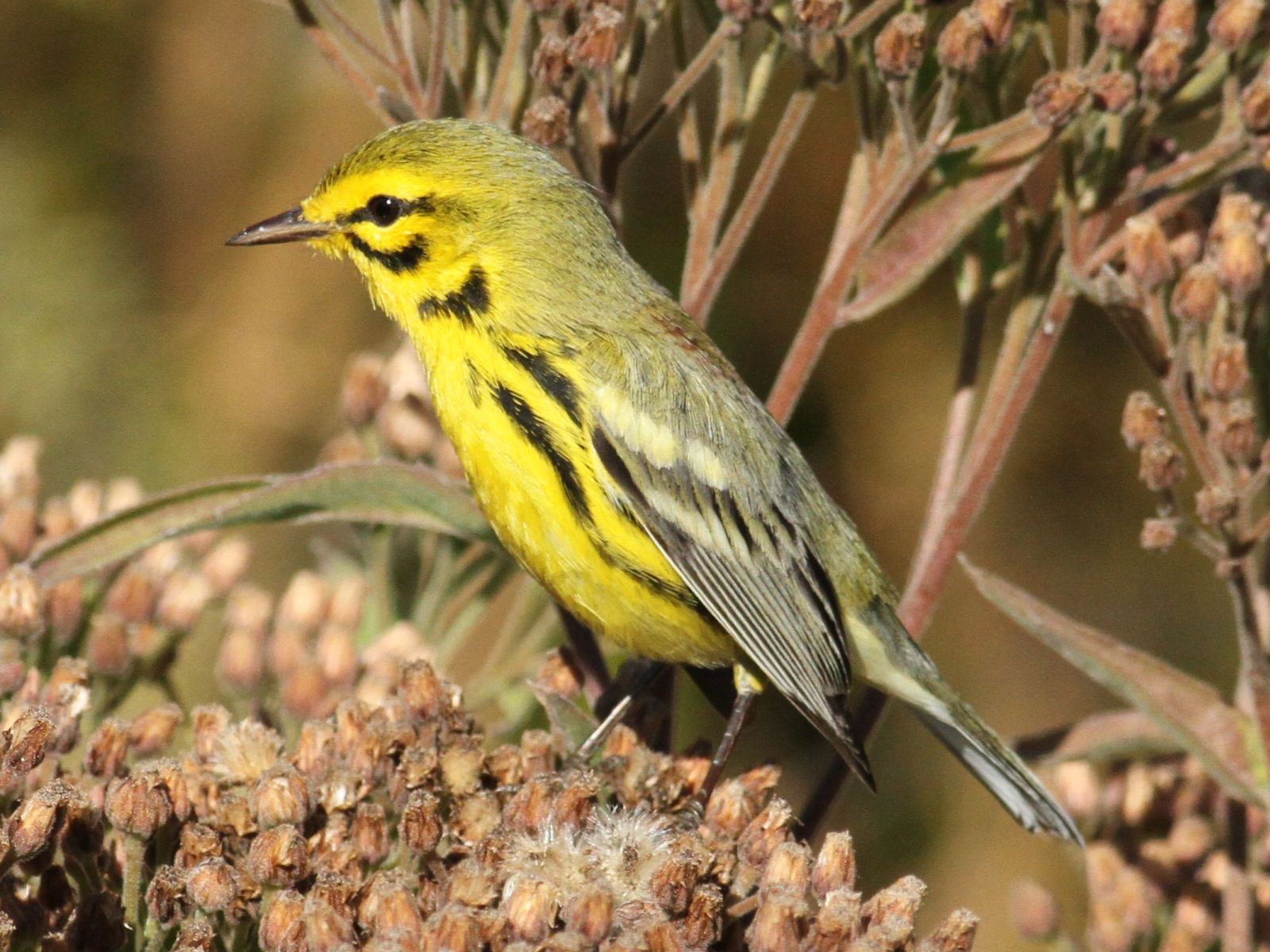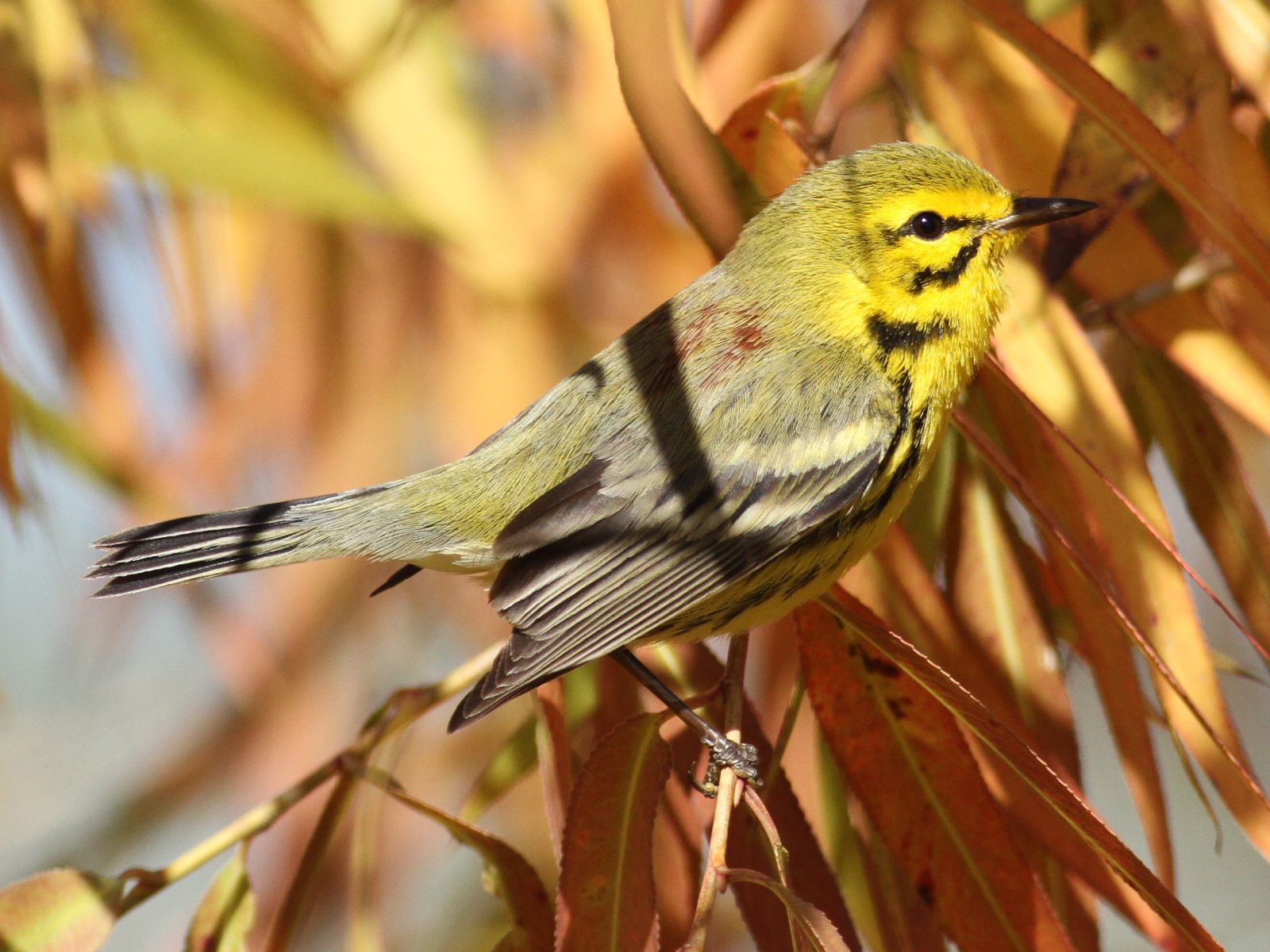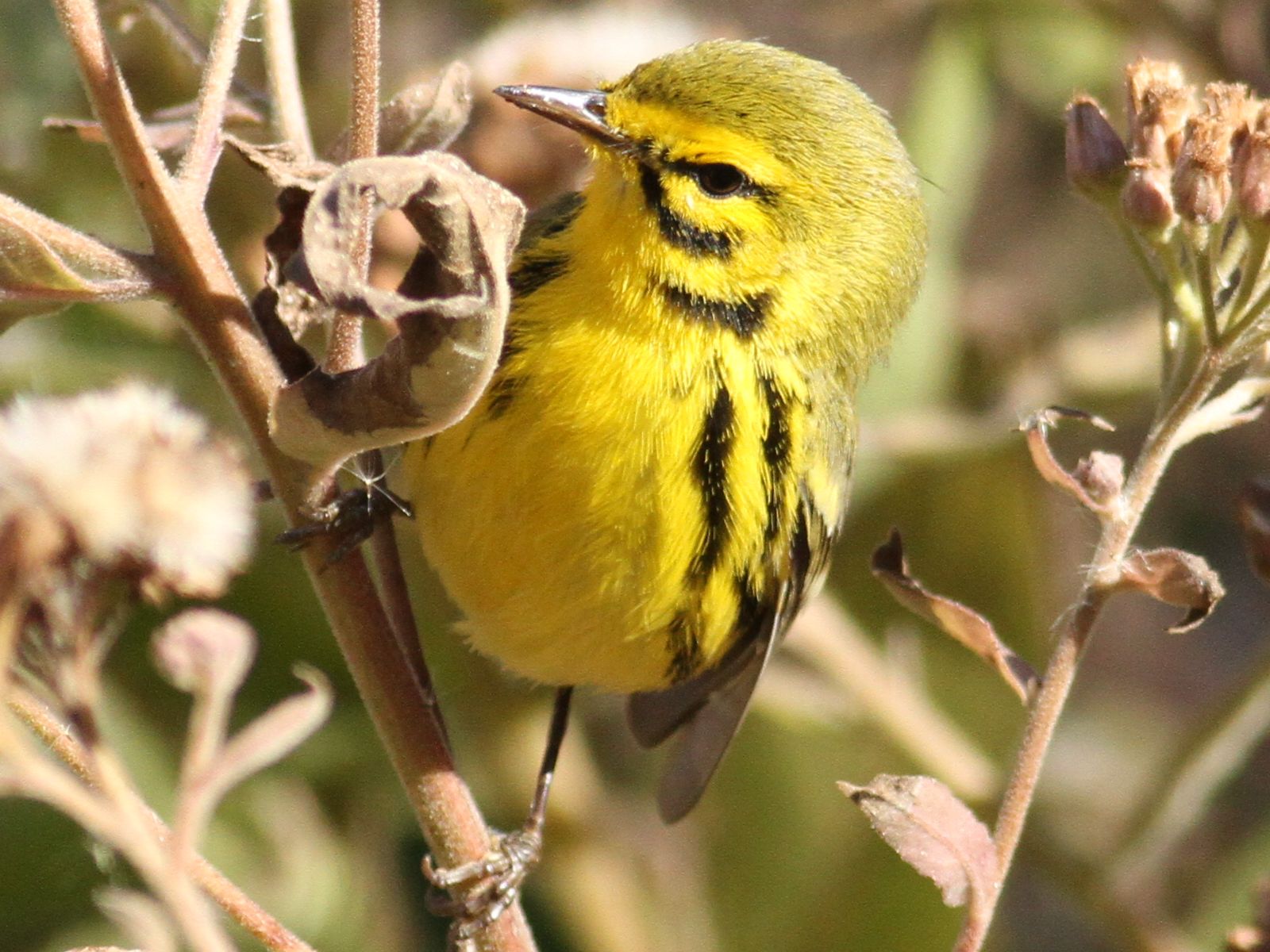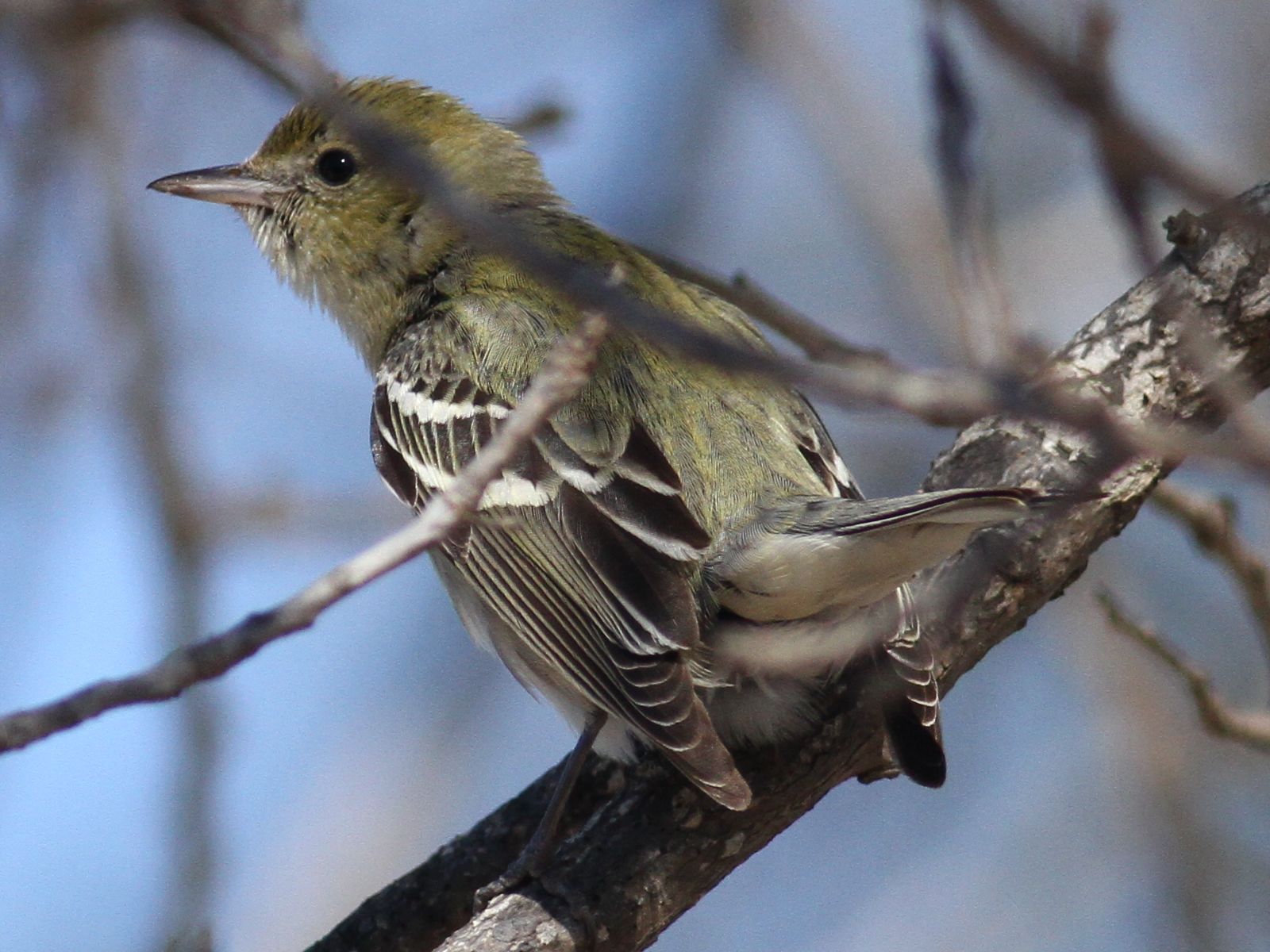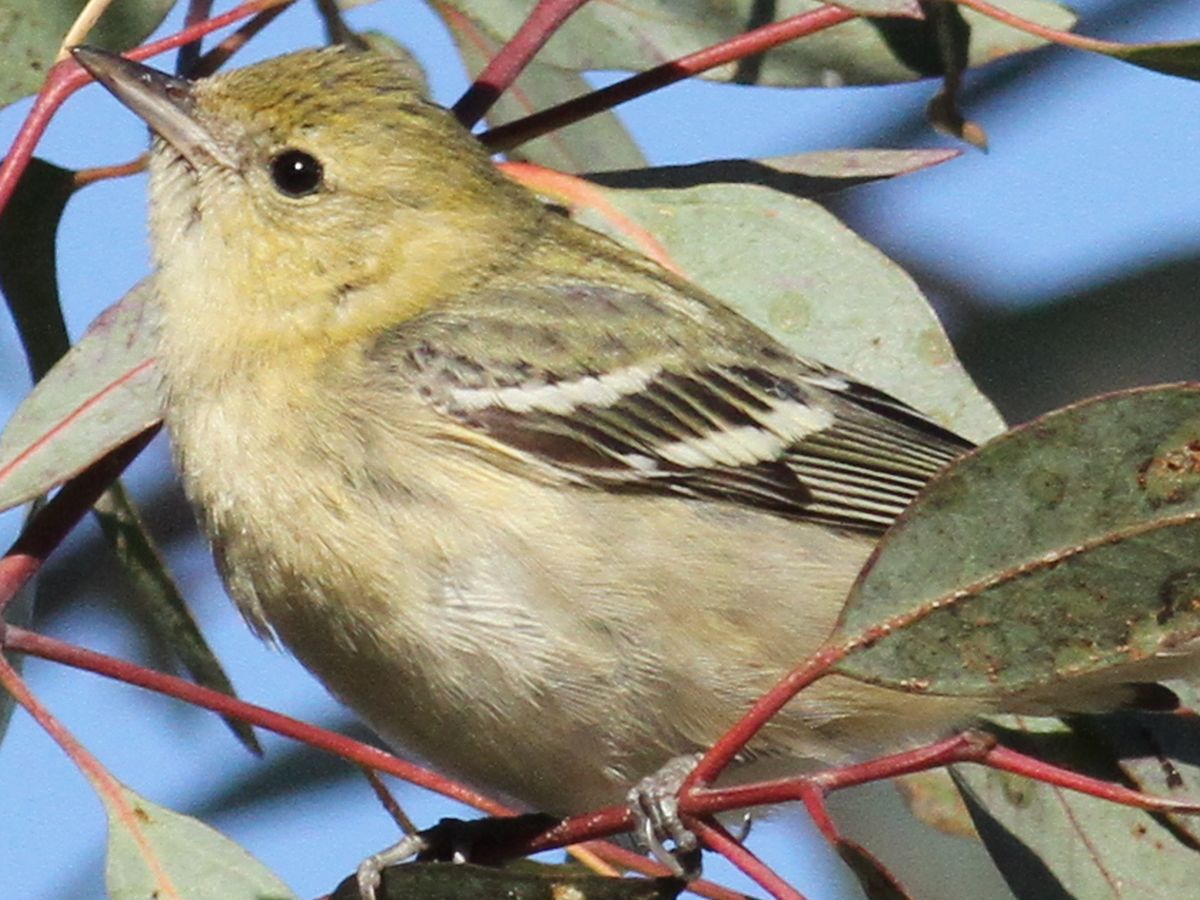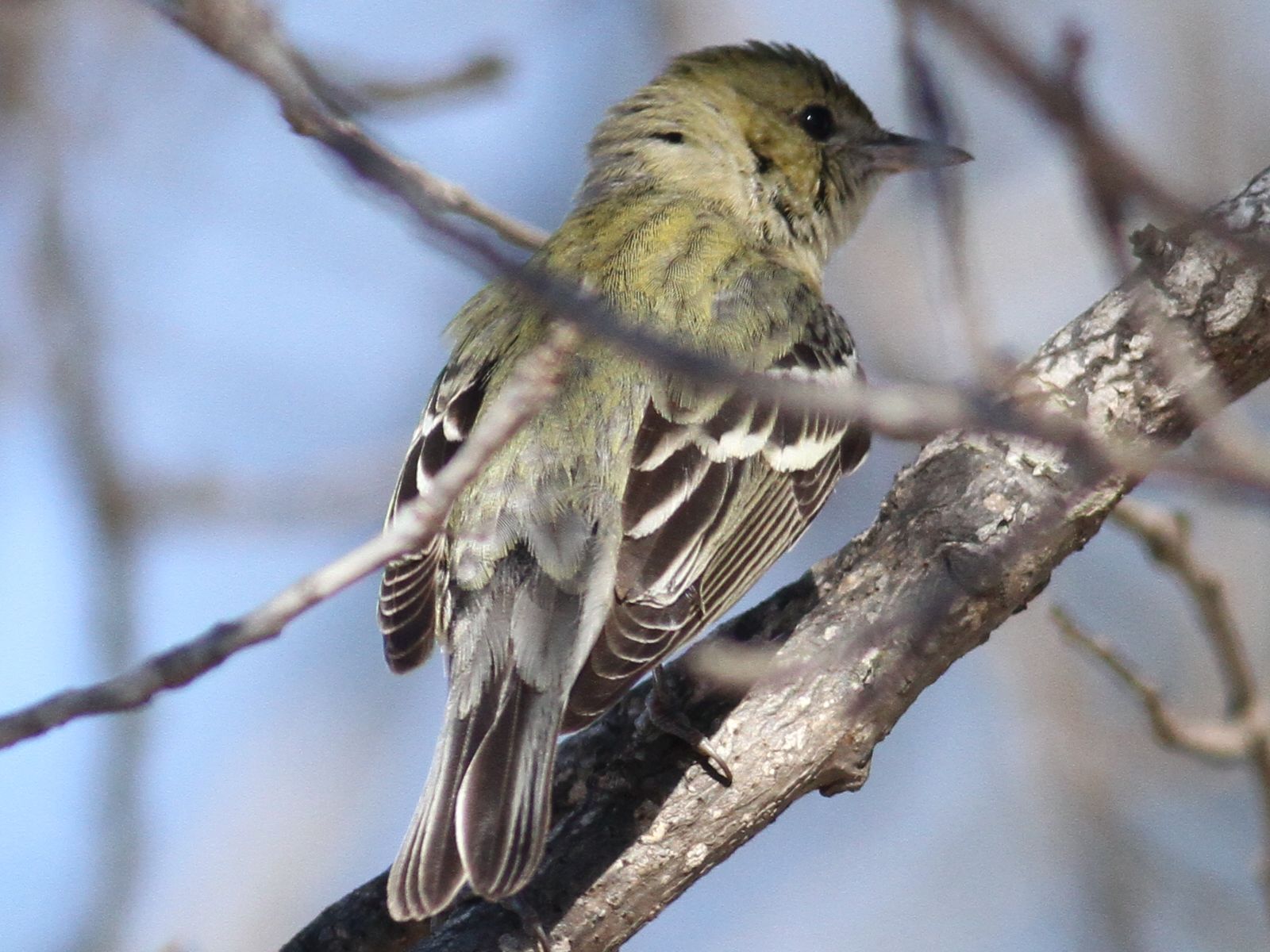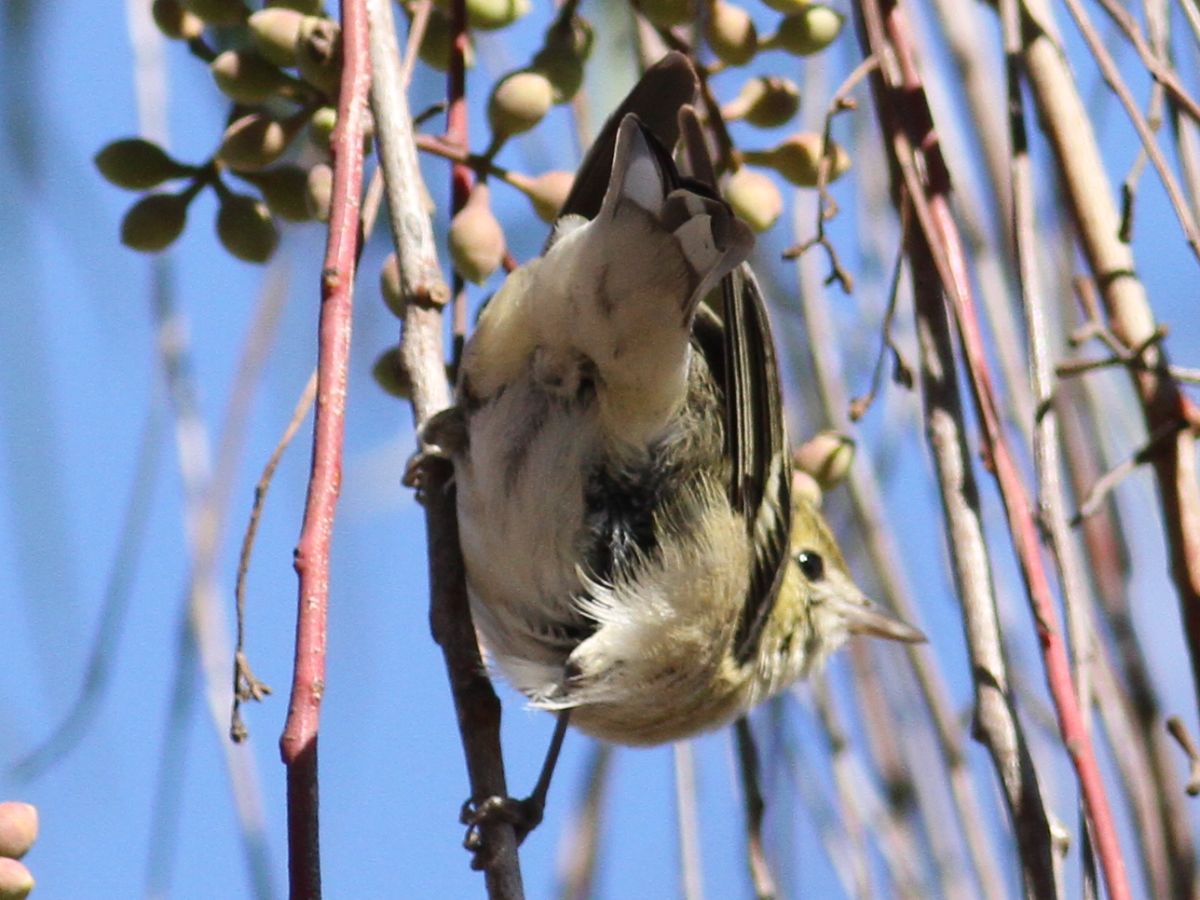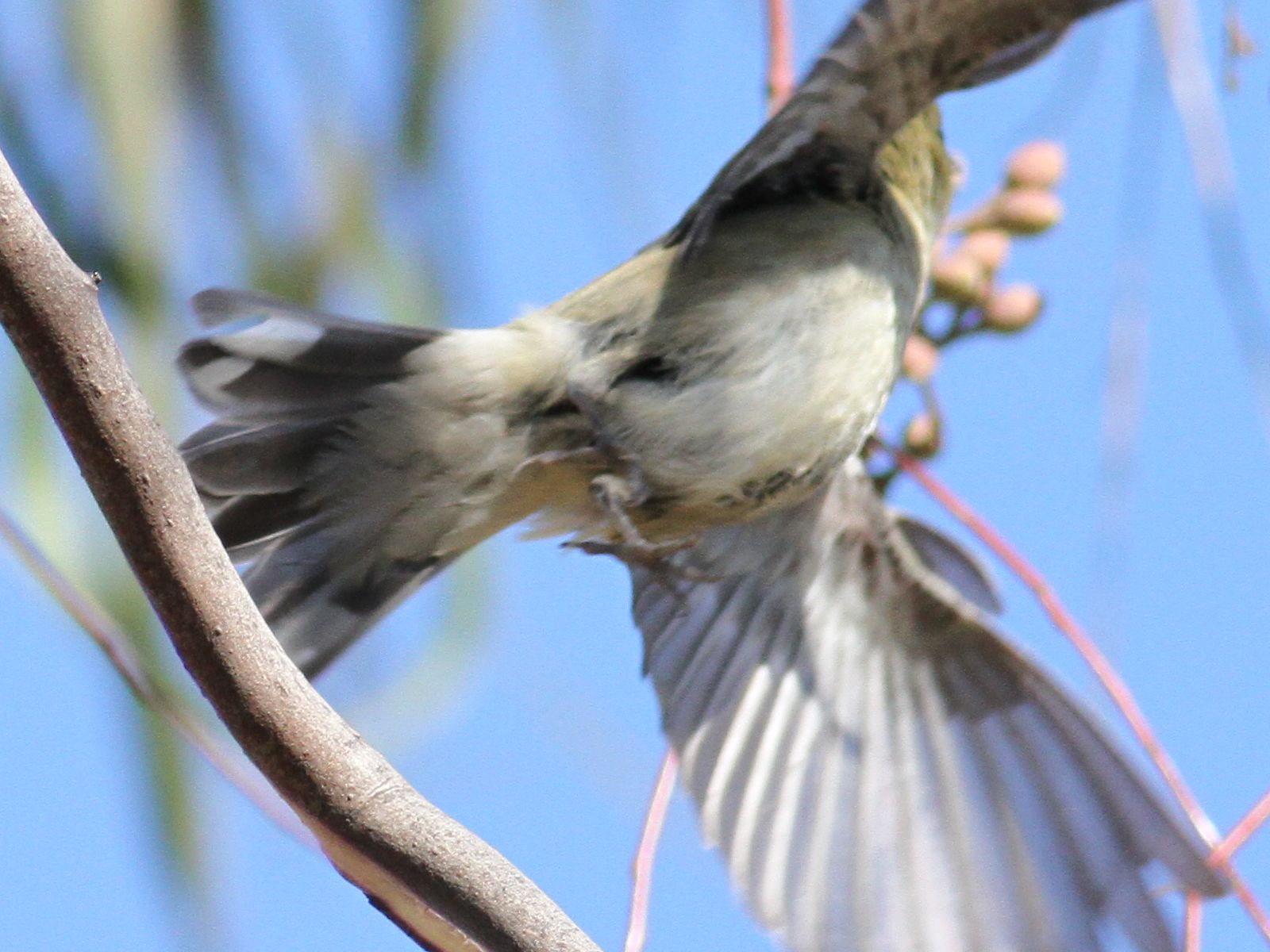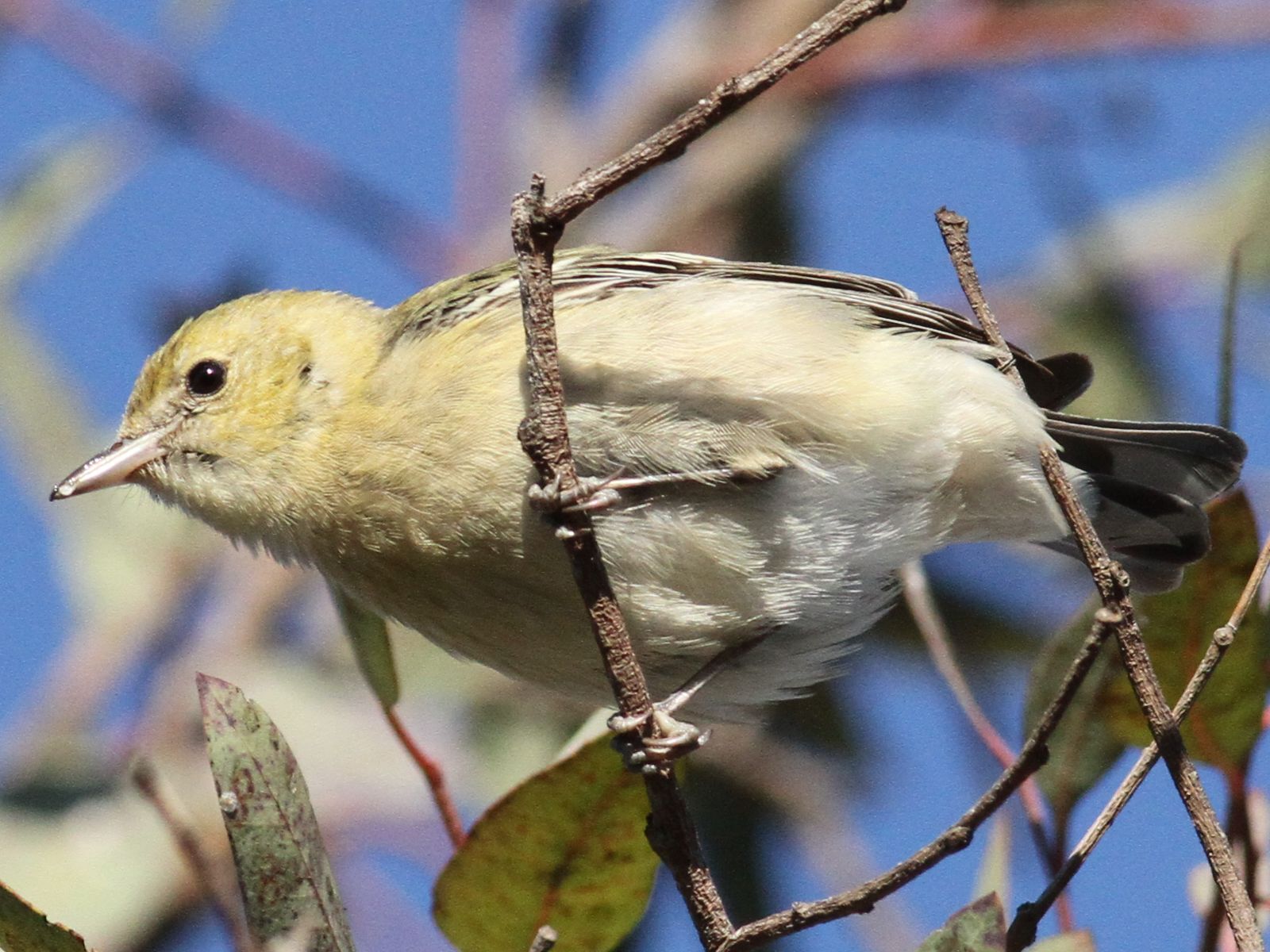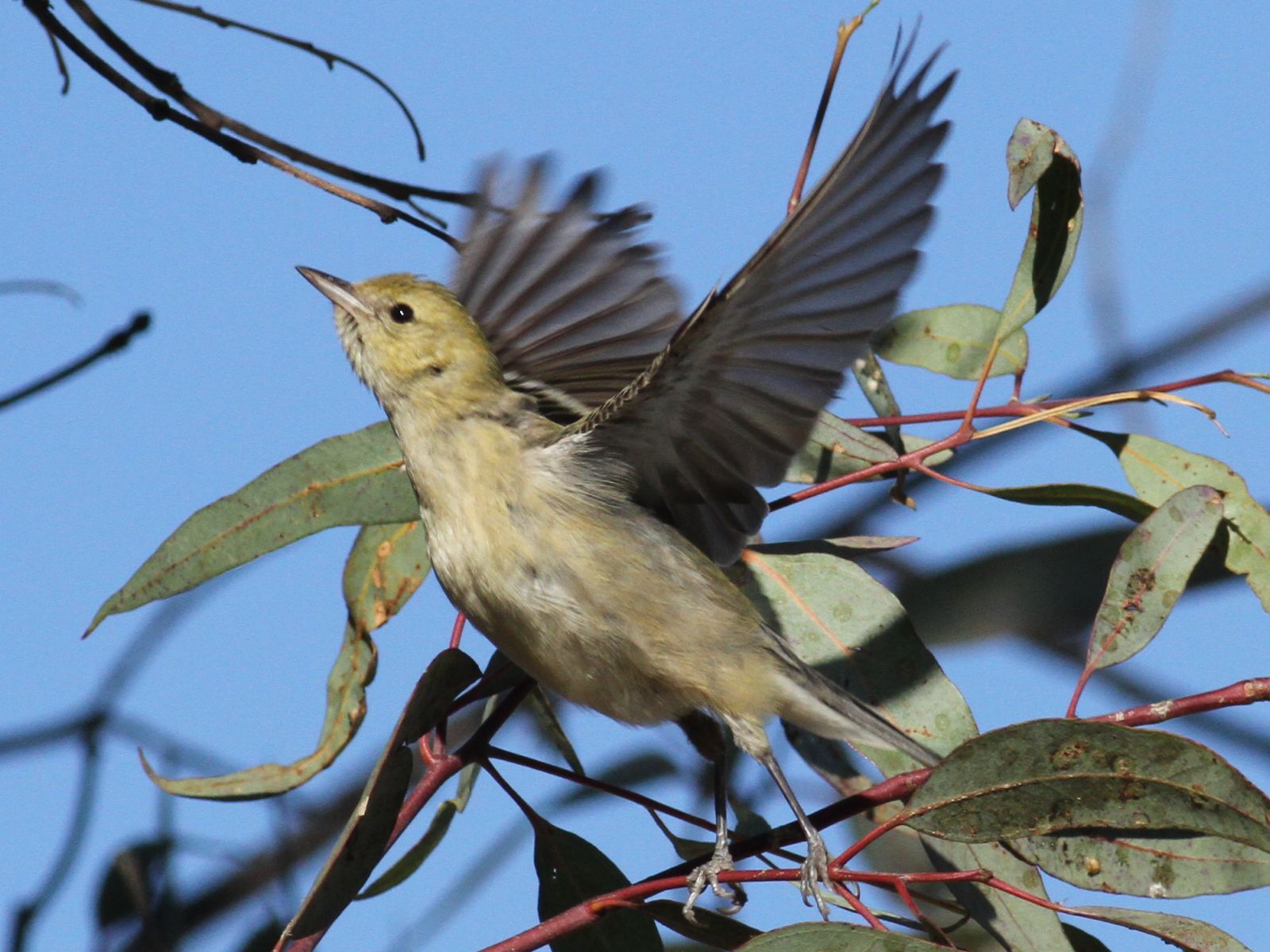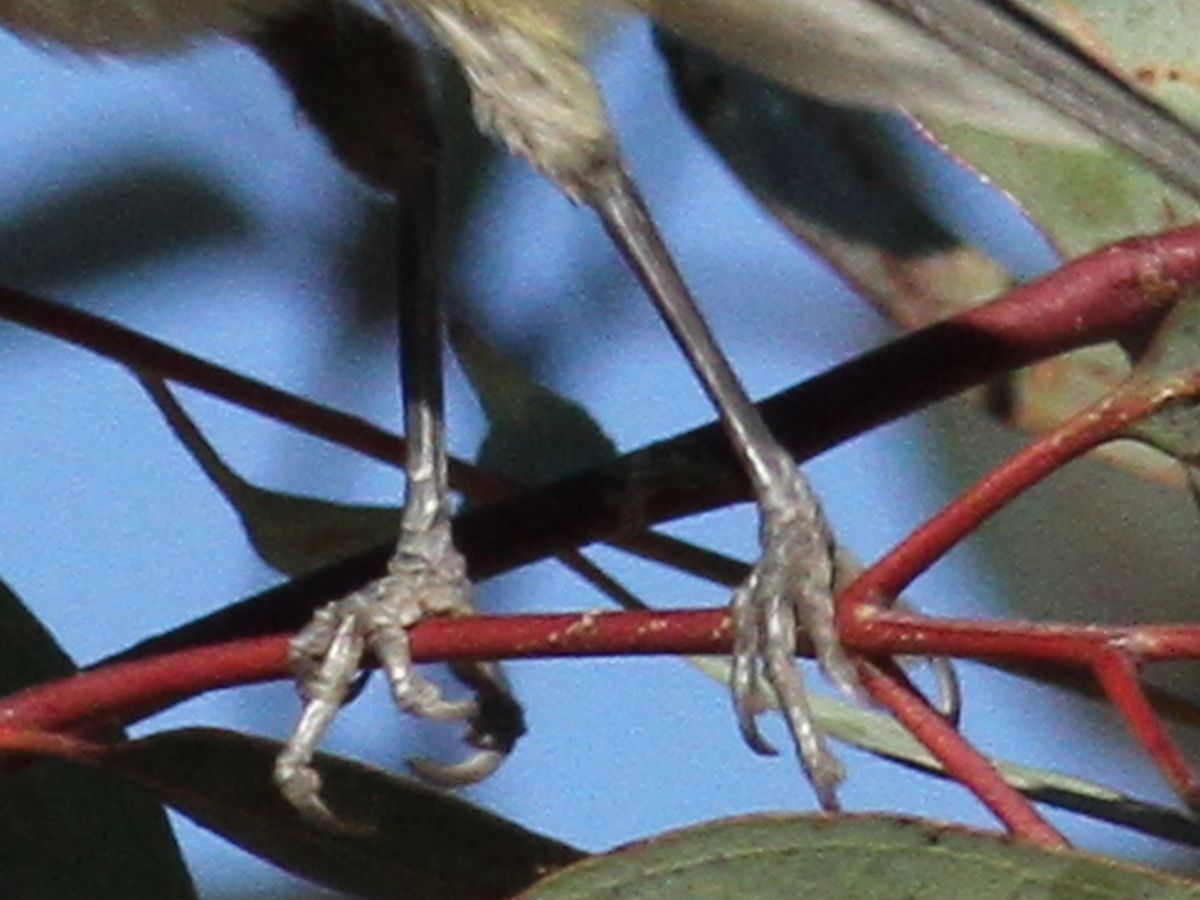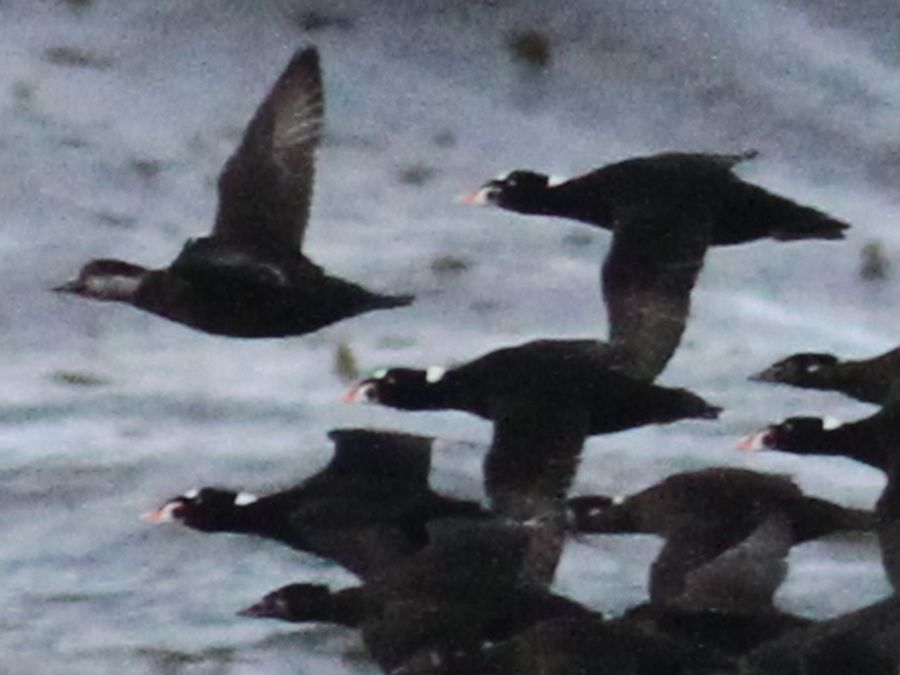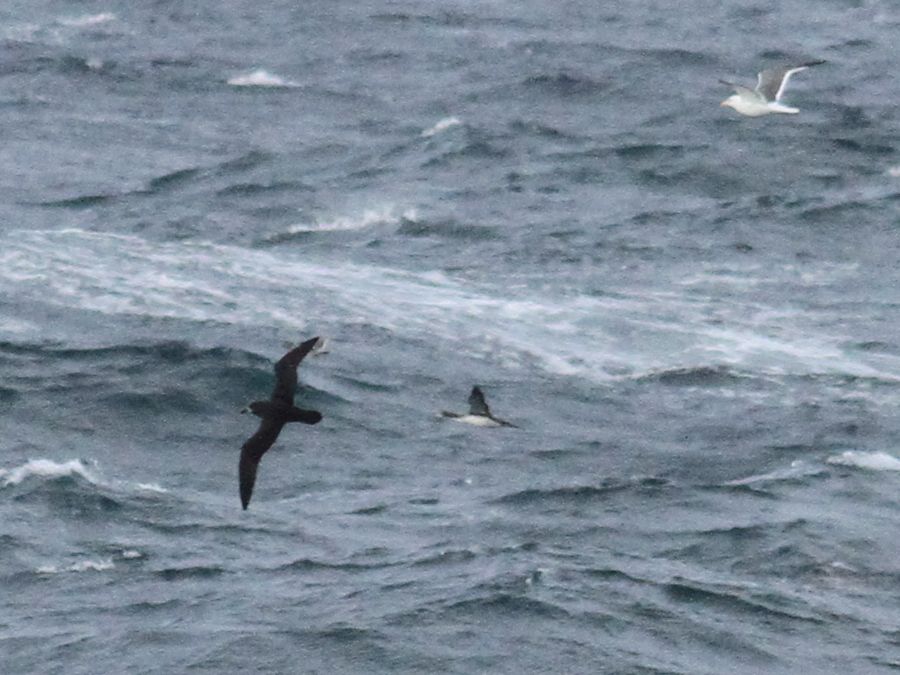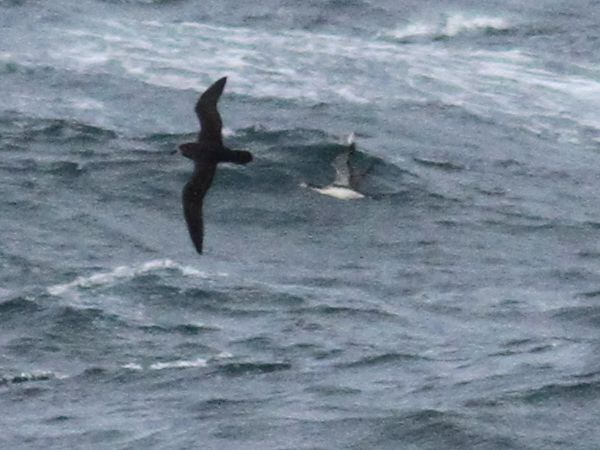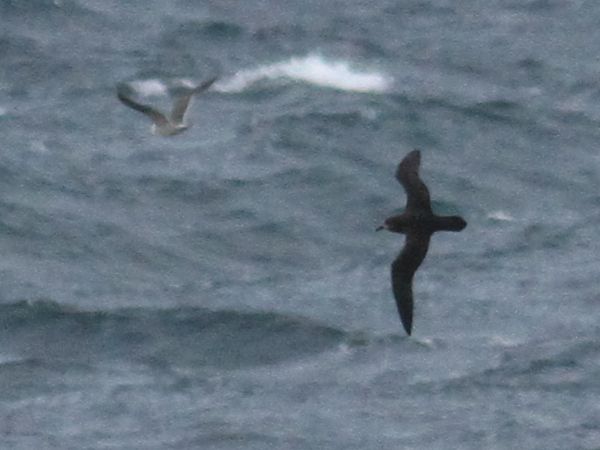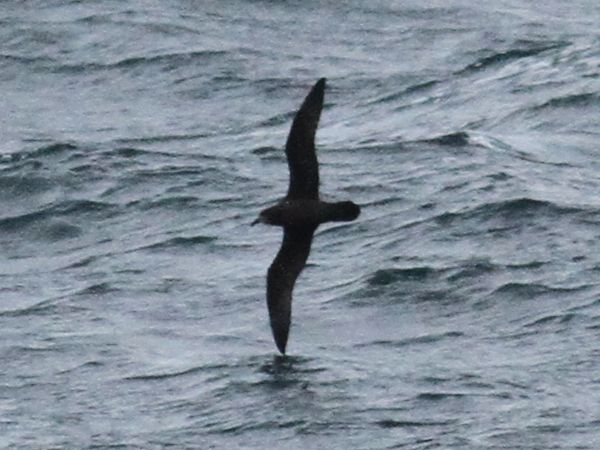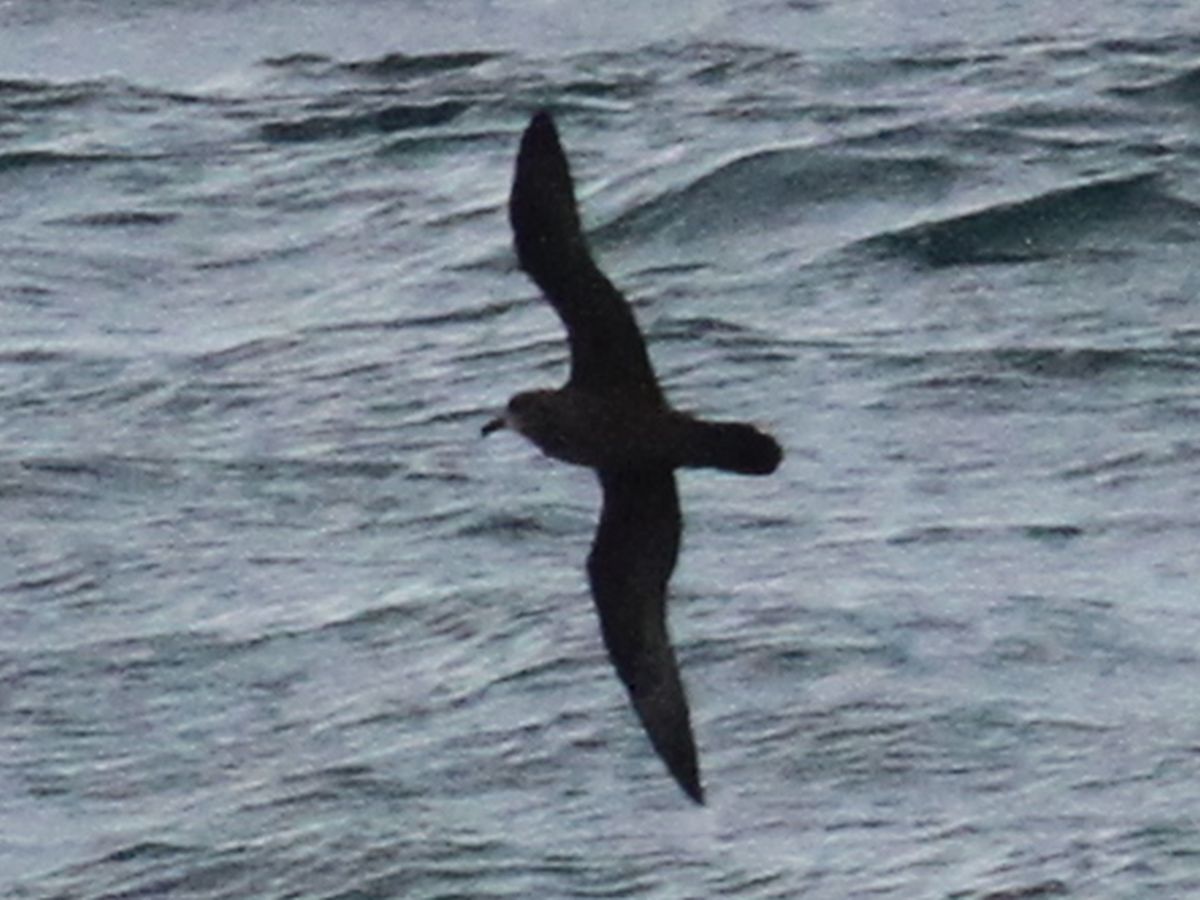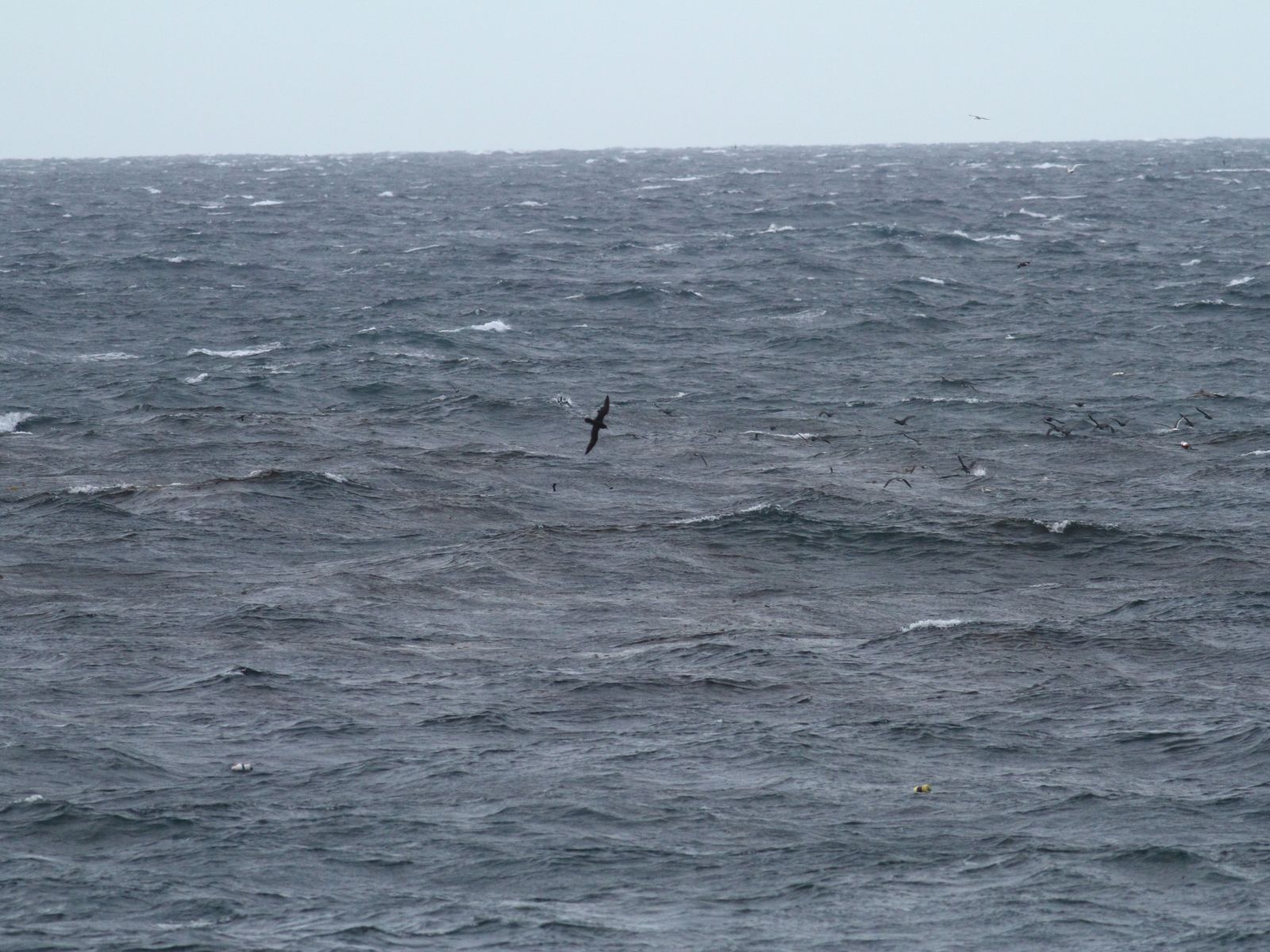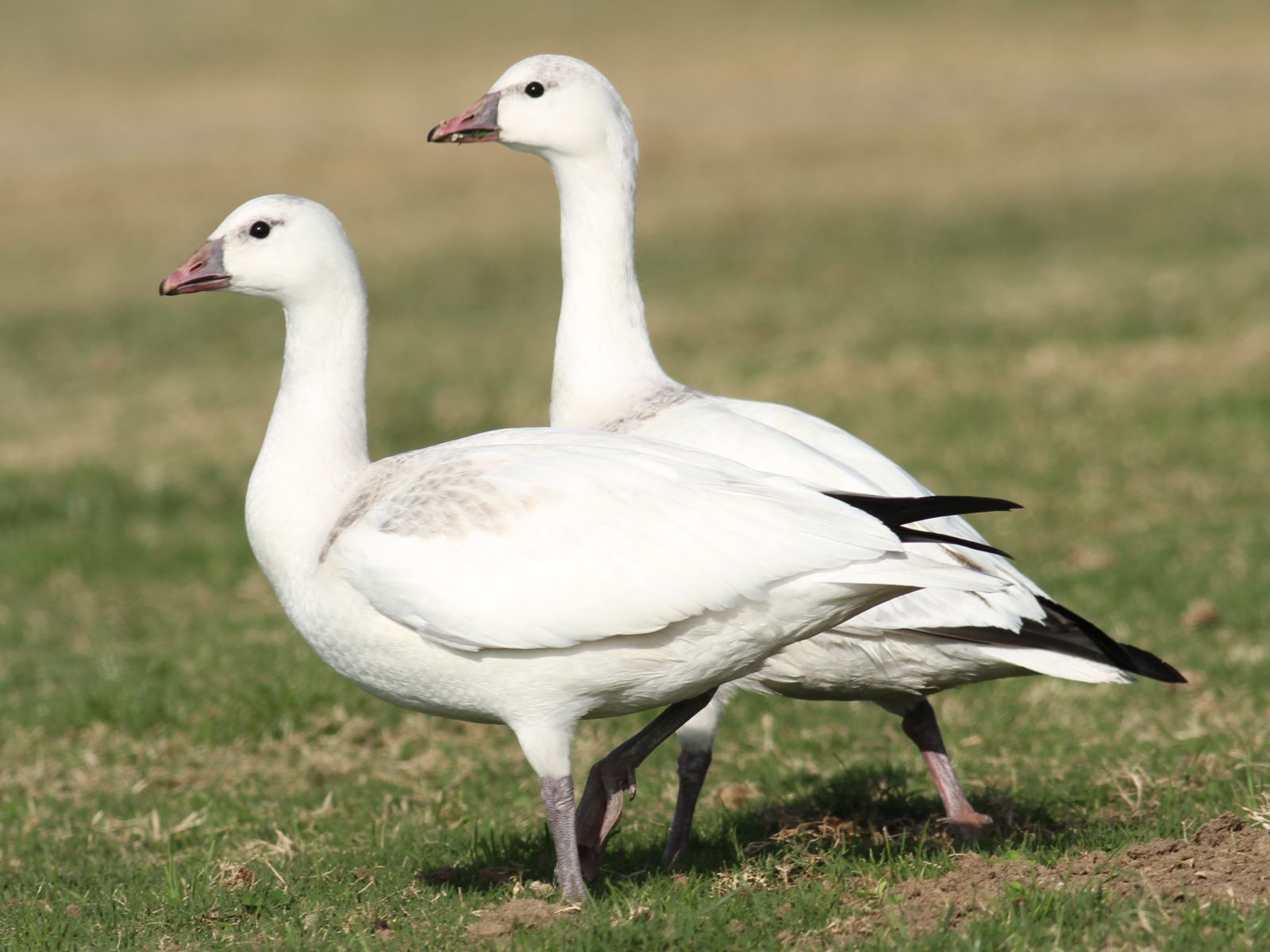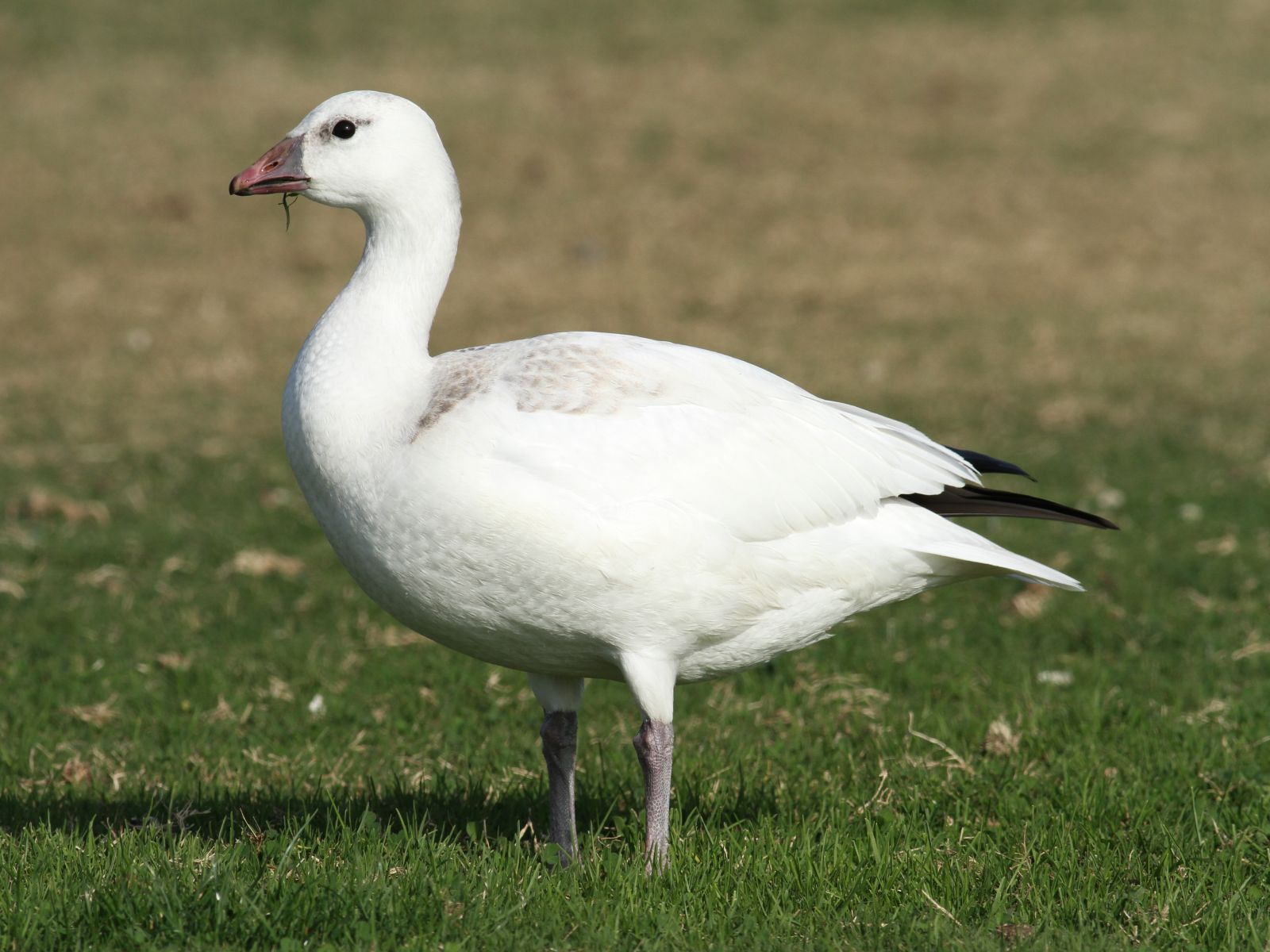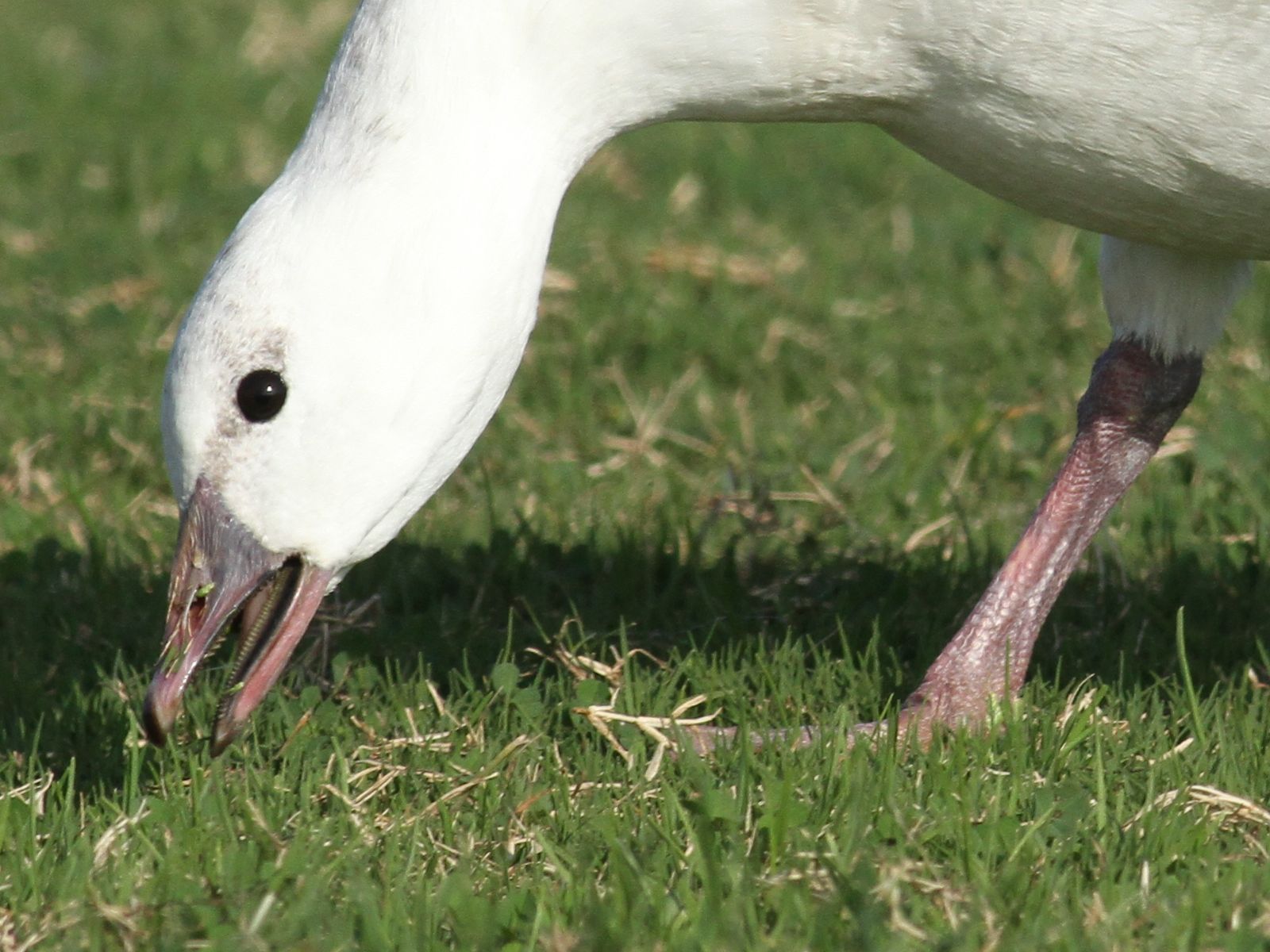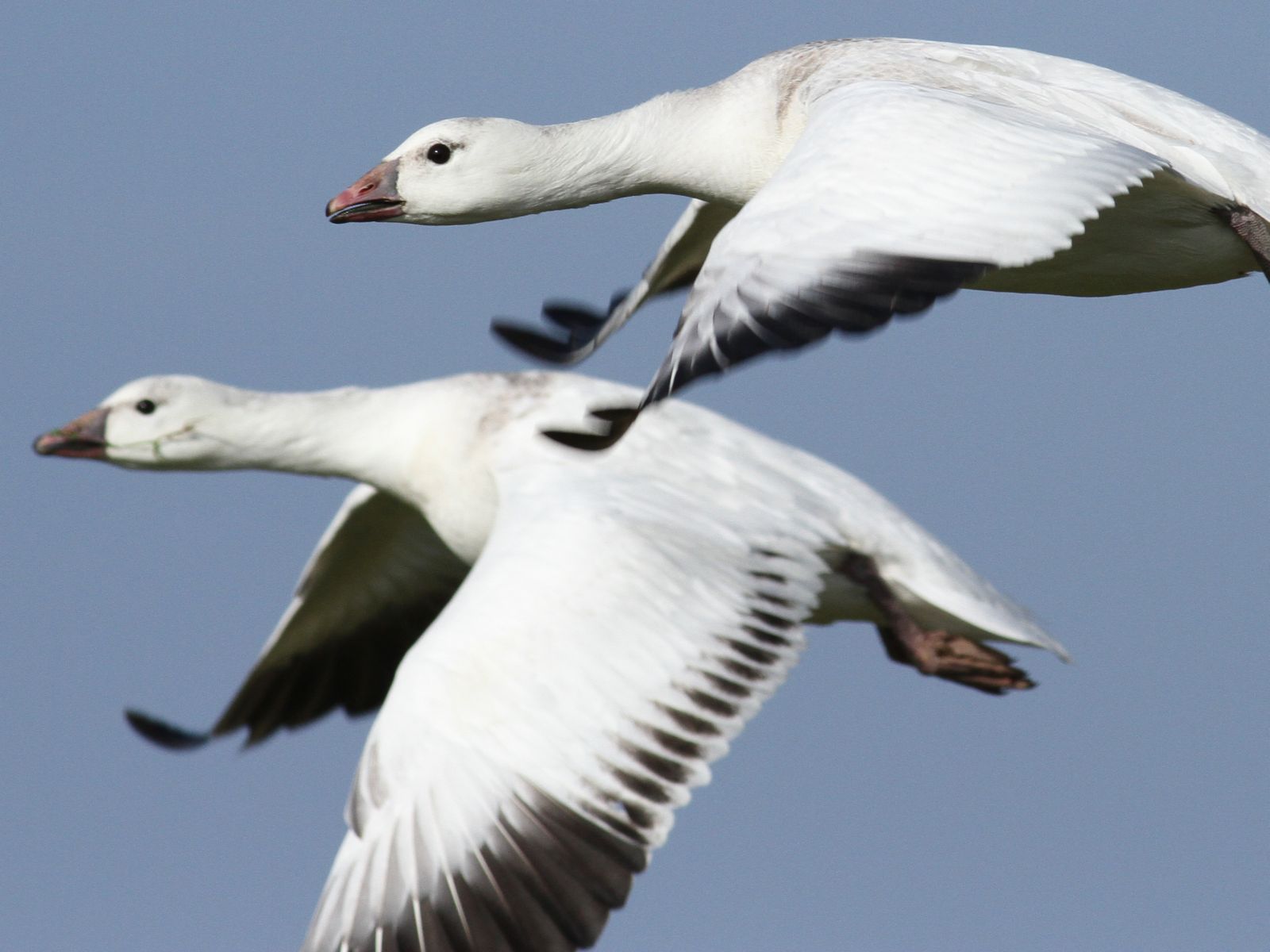[All photographs copyright, Gary Nunn 2013] – I made a circuit birding at some favorite spots around Point Loma after a stormy night with rain and gusty winds. There did not seem to be much bird activity anywhere, but finally, once the sun had come out along Silvergate Ave, there at last seemed to be some birds to look at! The best find was this dapper looking male Black-and-white Warbler Mniotilta varia which was busy feeding, nuthatch like, in pepper trees at the junction of Warner and Silvergate Avenue. This would appear to be a first spring male, the retained dusky brown remiges and rectrices contrast quite strongly with the bold black centers of the greater coverts. This bird was quite noisy and sounded the alarm, a repeated harsh “chip” call, at a nearby cat moving underneath the fir tree.
Author Archives: Gary Nunn
At last a Glaucous-winged Gull – Mission Bay
[All photographs copyright, Gary Nunn 2013] – There seems to be a deficiency of interesting gulls this winter along the coast of San Diego County. So when I spotted a large pale gull near the entry causeway to Fiesta Island, Mission Bay I quickly investigated! The gull was quite difficult to approach until a jetski passed nearby and happened to kill a fish just beneath the water surface. The floating fish body parts came alongside the shoreline and soon attracted this large-in-size second-cycle Glaucous-winged Gull Larus glaucescens into photographic range. It aggressively chased off nearby Western Gulls and soon had the fish remains to itself while dominantly guarding the area near the shore.
This gull is chesty and short bodied looking, typical for this species, with wings at rest hardly much longer than the tail by only a few primary feather tips. The off-center, forward-weighted look is quite prominent when it swims and even quite odd looking when seen from the side alighting. Several views also show well the broad width of the wings, in particular the secondaries, that help create the skirted looking effect known well in this species. Although the legs are quite dark looking there is an underlying pink color becoming evident.
This gull has a nice looking dark cappucino-brown colored iris, but the dark greyish eyering appears to have no other notable coloration developed so far as I could discern from the photographs. The strong looking dark bill has quite a pronounced gonydeal angle with some pale coloration at the base of both the upper and lower mandible (patchy). It also has a fine light-colored tip to the upper mandible.
Weekend highlights – 03 Feb 2013
[All photographs copyright, Gary Nunn 2013] – I spent the morning birding around San Diego with out of town visitors Lisa and Joel Swanstrom from Minneapolis, Minnesota. An early start found us at Point La Jolla, where the impressively large 6+ feet surf was crashing right on to the headland. The only seabirds of note were a continuous stream of Black-vented Shearwaters offshore, and one group of Rhinoceros Auklet, about a dozen strong, flying together south. We made a lucky check of the algae covered beach boulders in front of the point which yielded very close views of a basic plumaged Wandering Tattler Tringa incana. This was a new species for Lisa and Joel and afforded excellent views and saved us creeping out on the exposed seawall at The Children’s Pool, where this species is customarily seen. Nearby there was also a small flock of Black Turnstone, some Least Sandpipers, and a Sanderling rounded out the littoral waders that could be seen boulder hopping in the surf.
A late morning check of the Sweetwater River in Chula Vista, between Highland Ave and N 2nd Ave, found us a bright male Eurasian Wigeon Anas penelope in among the more numerous American Wigeon. After some close views it made a short flight upstream, where it quickly slid away to remain hidden from view underneath the bank of the tidal channel.
Leading male Black Scoter – Point La Jolla
[All photographs copyright, Gary Nunn 2013] – This wonderful looking seaduck was close to the top of my wishlist to spot flying by Point La Jolla! This morning the winds from the southwest had southbound bands of Surf Scoter, ten to fifteen at a time, pushed quite close to Point La Jolla. About the third flock going south had this fine looking adult male Black Scoter Melanitta americana leading the way. Easily picked out by the rich yellow colored swollen bill, it also flagged against the headwind occasionally revealing the paler underwing coloration of the flight feathers.
This is the second Black Scoter that I have seen at Point La Jolla this winter. An adult female, first spotted by Jay Keller, also passed south with Surf Scoters on 18 Dec 2012. In both cases the individual Black Scoter generally seemed well placed at the front leading the flock of Surf Scoters. It makes me wonder if there is some subtle difference in flying speed or a behavioral preference of some kind which keeps this species at the front – interesting!
Bird bounty of La Jolla Muirlands
[All photographs copyright, Gary Nunn 2013] – The Muirlands neighborhood of La Jolla has many impressively well wooded gardens providing food and cover for myriad good birds. Streets such as El Camino Del Teatro, La Cumbre Drive, Solymar Drive, and Inspiration Drive can all be productive turning up good finds. I made several visits over the last couple weekends discovering Western Tanagers, Summer Tanager, Hermit Warbler, Mountain Chickadees, Red-breasted Sapsuckers, White-breasted Nuthatch, and what seems to be endless inquisitive Red-breasted Nuthatches. Another good find was a shy “Slate-colored” Fox Sparrow buried in deep cover under a hedgerow. This area is definitely worth a visit if you are in the area, for example after a dawn seawatch from Point La Jolla is a good plan, by 9 am the temperatures are rising and insect activity picks up drawing out activity in the birds.
The classy Canvasback – Rose Creek, Mission Bay
[All photographs copyright, Gary Nunn 2013] – In the last couple of years of looking at wintering ducks on Mission Bay I do not recall seeing a Canvasback Aythya valisineria before so this was quite a nice local patch find! There are many ritzy looking Redhead on the bay right now but the shape and deep chestnut head of the Canvasback is just so classy looking in my opinion. The negative tide, about minus 1.4 feet, had drawn down the water in Rose Creek substantially, and many diving and dabbling ducks had collected there milling around feeding in the shallows. I spotted this splendid male Canvasback paddling toward the bikepath bridge over Rose Creek (west terminus of North Mission Bay Drive). It looked quite edgy by itself and suddenly took off flying strongly toward the bay, but then veered directly around and flew back right over me on the bridge! I last saw it cupping its wings as it settled in to Rose Creek, just north of Grand Avenue in Pacific Beach. A tiny area of open water so it should not be difficult to relocate!
Warbler madness at Lower Otay Lake
[All photographs copyright, Gary Nunn 2012] – I almost went early this morning to Lower Otay Lake, Chula Vista, to look for the Blackpoll Warbler reported yesterday, but decided to go birding later once the temperature warmed up. As several very experienced California birders pointed out, this is a very unusual winter date for a Blackpoll Warbler and worth investigating. So when word came out that the identification had been revised to a much rarer Bay-breasted Warbler, along with the discovery of a Prairie Warbler no less, I jumped in the car and headed down to the lake! By the sound of things a posse of local birders had been picking over the rare warbler finds!
This adult male Praire Warbler was discovered by local birder BJ Stacy in the small willows along the edge of Lower Otay Lake just on the north side of the boat ramp. It was very mobile while I watched it move among willow trees dotted along several hundred yards of shoreline both north and south of the boat ramp. It even flew out to the submerged willow islands near the end of the jetty at one point! It did occasionally come very close and, since it was feeding low in the bushes, provided excellent photographic opportunities.
Originally reported on 30 Dec 2012 as a Blackpoll Warbler, this bird is perhaps the most difficult identification challenge among the Parulidae Wood-Warblers. The next day local birders Jay Keller and BJ Stacy relocated the warbler, joined later by Paul Lehman and Guy McCaskie, and revised its identification as a much rarer Bay-breasted Warbler! There are several key diagnostic features that contribute to its identification including most importantly the evenly blue-grey colored legs and feet (including soles of the feet) which can be seen in the photographs below. I also think the undertail coverts have a slight buffy coloration, at least at the sides where they meet the flanks, which is another feature of Bay-breasted Warbler. Looking at details of the plumage from the photographs this appears to be an adult female. Only the outer two rectrices have white markings, and the white mark on r5 is small. In addition the rump has a noticeable lead grey coloration that contrasts with the yellowish-green upperparts.
Leading the pack – adult female Black Scoter
[All photographs copyright, Gary Nunn 2012] – Amid the excitement of finding and photographing San Diego County’s first Great-winged Petrel I had forgotten about this nice adult female Black Scoter Melanitta americana that was spotted by local birder Jay Keller. Jay arrived just twenty minutes after the petrel came by the point and he immediately picked out the Black Scoter among a pack of fast-moving Surf Scoter while waiting patiently to see if the petrel would return. The buffy cheek, throat and neck, clearly demarcated from the completely dark brown upper and underparts indicates this is an adult female Black Scoter. This bird shows off some interesting paler edges to the primaries as well as whitish “dots” on the tips of the secondaries, the latter particularly visible from beneath. Adults undergo definitive prebasic molt by November so perhaps this is a feature of the new plumage.
Magic moment – Great-winged Petrel at La Jolla Cove
[All photographs copyright, Gary Nunn 2012] – Sometimes there are just magic moments birding. Today I was thinking it was all so ho-hum when along came this beautiful sooty-brown tubenosed seabird making agile sweeping arcs in flight over the kelp beds of La Jolla Cove. I took one look at this bird making switchbacks in front of me and new immediately it had to be photographed!! Close examination of the photographs reveals this is a Great-winged Petrel Pterodroma macroptera. It can be distinguished from the closely similar Providence Petrel P. solandri (also known as Solander’s Petrel) by the fully dark underwing including completely dark underside to the primaries and underwing primary coverts. Other distinguishing features include the saber like wing shape, bulky “fat” medium length wedge-shaped tail, and the overall dark brown concolorous plumage except for the pale peppering around the bill base. The strong black bill is also noticeable. This bird flew in agile, graceful high arcs interspersed with slower wingtip touching the water style flights. It circled several times among other birds collected over the near shore kelp bed before disappearing to the south. Based on time stamps from my 118 images it was in view for less than two minutes! All photographs below are shown without adjustments to original color or contrast.
There are currently five accepted records of Great-winged Petrel in California with another one under consideration, the nearest to San Diego coming from Monterey County in 1998. Great-winged Petrel was seen as recently as September 2011, pending acceptance by the California Bird Records Committee, from a Half Moon Bay, San Mateo County pelagic run by Debi Shearwater. This bird would seem to be somewhat later than previous California records which occurred during July through October. The pale peppering around the bill base, in particular the chin, may indicate this is a form of Great-winged Petrel known as “Grey-faced” Petrel P. m. gouldi although juveniles of the nominate macroptera are noted as having pale feathering of the face also. Certainly the gouldi form has been positively identified in California previously and this bird could well be that form also. It seems most likely this is an adult bird because juveniles are only leaving their nests in the Southern Hemisphere in early December.
In the ABA area Great-winged Petrel has only been recorded from California and is currently categorized as a Code-5: Accidental which means there are five or less records in the ABA area. This record would constitute the 6th or 7th record dependent on the acceptance of the September 2011 record. It is the first Great-winged Petrel to be seen from shore anywhere in the ABA area.
Ross’s Geese at the baseball field!
[All photographs copyright, Gary Nunn 2012] – I was driving out of Robb Field, Ocean Beach when I noticed two suspiciously small white birds feeding on the short turf of the main baseball pitch. Dwarfed by nearby Western Gulls there was no mistaking two white morph Ross’s Goose Chen rossii feeding happily on the tender green grass shoots. Occasional batted balls went flying by and a dog flushed them but they kept on coming back for the good grazing! In one of the flight shots you can see the dark marked secondaries of the hatch year bird in the background and the white secondaries of the adult in the foreground. The hatch year bird also has greyish legs while the adult has pink legs and shows a more wrinkled look to the bill.


